Seabee
| Naval Construction Battalions | |
|---|---|
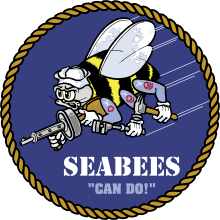 The Seabee logo | |
| Founded | 5 March 1942 |
| Country |
|
| Branch |
|
| Role | Militarized construction |
| Size |
|
| Nickname(s) | Seabees |
| Motto(s) |
|
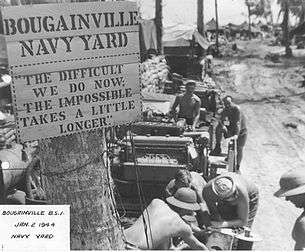

United States Naval Construction Battalions, better known as the Seabees, form the Naval Construction Force (NCF) of the United States Navy. Their nickname is a heterograph of the first initials "C.B." from the words Construction Battalion.[1][2] Depending upon the use of the word, "Seabee" can refer to one of three things: all the enlisted personnel in the USN's occupational field-7 (OF-7), all officers and enlisted assigned to the Naval Construction Force, or the U.S. Naval Construction Battalions (CBs).
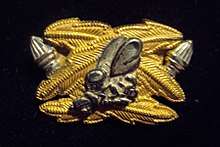
Naval Construction Battalions were conceived of as a replacement for civilian construction companies working for the US Navy after the United States was drawn into World War II with the Japanese attack on Pearl Harbor on 7 December 1941. At that time the U.S. had roughly 70,000 civilians working on military installations overseas.[3] International law made it illegal for them to resist enemy attack, as to do so would classify them as guerrillas, for which they could be summarily executed,[4] which is exactly what happened when the Japanese invaded Wake Island.[5]
The Seabees would consist of skilled workers that would be trained to drop their tools if necessary and take up their weapons at a moment's notice to defend themselves.[6][7] The concept model was that of a USMC–trained battalion of construction tradesmen (a military equivalent of those civilian companies) that would be capable of any type of construction, anywhere needed, under any conditions or circumstance. It was quickly realized that this model could be utilized in every theater of operations, as it was seen to be flexible and adaptable.
The use of USMC organization allowed for smooth co-ordination, integration or interface of both the NCF and Marine Corps elements. In addition, Seabee Battalions could be deployed individually or in multiples as the project scope and scale dictated. What distinguishes Seabees from Combat Engineers are the skill sets. Combat Engineering is but a sub-set in the Seabee toolbox. They have a storied legacy of creative field ingenuity, stretching from Normandy and Okinawa to Iraq and Afghanistan. Admiral Ernest King wrote to the Seabees on their second anniversary, "Your ingenuity and fortitude have become a legend in the naval service."[8] Seabees believe that anything they are tasked with they "Can Do" (the CB motto). They were unique at conception and remain so today. In the October 1944 issue of Flying magazine the Seabees are described as "a phenomenon of World War II".[9] In 2017, the Seabees celebrated their 75 years of service without having changed from Admiral Ben Moreell's conceptual model.
World War I precursor
In 1917, the Twelfth Regiment (Public Works)[10] was organized at Naval Training Station Great Lakes.[11] When the US entered World War I in April 1917, the Navy had an immediate requirement to expand the Great Lakes Station in order to house, process, and train 20,000 naval recruits, this number would rise to 50,000 by the end of the year.[11] Lieutenant Malachi Elliott, a graduate of the US Naval Academy, was appointed Public Works Officer at Great Lakes on 18 June 1917, at which time about 500 enlisted men had been assigned to the Public Works Department.[11] Seeing that the department would need to expand with skilled craftsmen, architects, draftsmen, designers, and other professional and technical people, he began to screen incoming recruits with these skills. Finding many, but not enough, he expanded to recruiting civilians outside of the installation, getting many men willing to join the Navy as petty officers, with the understanding that qualified men could later apply for commissions.[11] This allowed the Public Works Department to grow to nearly 600 men by July 1917. They were organized into the Twelfth Regiment (Public Works), which was essentially the Public Works Department because staff officers could not exercise military command. Lieutenant William C. Davis was appointed commanding officer of the regiment, he exercised military control, but the Public Works Officers exercised technical control.[11] In October 1917, the regiment began building Camp Paul Jones at San Diego. With its completion, on 30 December 1917, the regiment became "fully operational" with 1,500 men organized into three battalions.[11] By April 1918, the regiment consisted of 2,400 in five battalions. Men were withdrawn for assignments in the US and abroad. In spring of 1918, 100 men were given special mechanics and ordnance training before being sent to St. Nazaire, France, to assemble Naval Railway Batteries. Later they would join the gun crews and perform combat duties along the railway lines in proximity to the German lines.[11] The Twelfth Regiment reached its peak strength 5 November 1918; 55 officers and 6,211 enlisted men formed into 11 battalions. However, with the end of the war on 11 November 1918, the regiment gradually faded away by the end of 1918.[11]
Formation
In the early 1930s, the idea that the Twelfth Regiment pioneered was still in the minds of many Navy Civil Engineers. The planners of the Bureau of Yards and Docks (BuDocks) began providing for "Navy Construction Battalions" in their contingency war plans. In 1934 Captain Carl Carlson's version of the plan was circulated to the Navy Yards, this idea of "Navy Construction Battalions" would later be tentatively approved by Chief of Naval Operations, Admiral William Harrison Standley. In 1935, Rear Admiral Norman Smith, Chief of BuDocks, selected Captain Walter Allen, the War Plans Officer, to represent BuDocks on the War Plans Board. Captain Allen presented the bureau's concept of "Naval Construction Battalions" to the Board.[12] The concept was later adopted for inclusion in the Rainbow war plans.[11] However, a major weakness to this "Navy Construction Battalions" concept was that there would be dual control of the battalions; military control would be exercised by Navy officers while the construction side would be controlled the Navy Civil Engineer Corps officers. There would be no provision for good military organization and military training, which was felt to be requisite to creating high morale, discipline, and cooperation among the men. The plans also only allowed for the battalions to be formed to build training stations throughout the US and only on completion be moved to forward areas.[11] Rear Admiral Ben Moreell became the Chief of BuDocks in December 1937, a post he would hold through the war. With tensions rising in both Europe and Asia, authorization was sought, and quickly received, by the United States Congress for expansion of naval shore bases. New construction was started in the Caribbean and Central Pacific in 1939. These were awarded to private construction firms that would perform the work with civilian personnel under the administrative direction of a Navy Officer in Charge of Construction.[11]
World War II
.svg.png)
.

By summer of 1941 civilian contractors were working on large naval bases at Guam, Midway, Wake, Pearl Harbor, Iceland, Newfoundland, Bermuda, and many other places. BuDocks decided there was a need to improve the Navy's supervision of these projects through the creation of "Headquarters Construction Companies". The men in these companies would report to the Officers in Charge of Construction and would be draftsmen and engineering aids needed for the administrative functions of the inspectors and supervisors overseeing the contracted work. These companies would consist of two officers and 99 enlisted men, but were not to do any actual construction. Rear Admiral Chester Nimitz, Chief of the Bureau of Navigation, authorized the formation of the first Headquarters Construction Company, on 31 October 1941. Recruitment started in November and as history would have it the company was formed on 7 December[8] with the men undergoing boot training at Naval Station Newport, Rhode Island. By 16 December 1941, four additional companies had been authorized, but 7 December happened, plans changed and with them the ratings needed by a change in mission. The first HQ Construction Company provided the nucleus for the formation of the 1st Naval Construction Detachment sent to Bora Bora in January 1942. Those men were part of Operation Bobcat[14] and are known in Seabee history as the "Bobcats". In December 1941, Rear Admiral Ben Moreell, Chief of BuDocks, recommended establishing Navy Construction Battalions and on the 28th requested authority to carry this out. On 5 January 1942, he got the go-ahead from the Navy's Bureau of Navigation to recruit construction tradesmen for three Naval Construction Battalions. When Admiral Moreell submitted his request to form those Battalions the other four HQ Construction Companies had been approved and authorized, so HQ Companies 2 & 3 were combined to form the 1st Naval Construction Battalion (and then were deployed as the 2nd & 3rd Construction Detachments) followed by HQ Companies 4 & 5 being combined to form the 2nd Naval Construction Battalion (and deployed as the 4th and 5th Construction Detachments).[11] While those four HQ Companies provided the nucleus for two Construction Battalions they were all deployed in a manner similar to the First Construction Detachment and this sort of thing continued through the 5th NCB.[15] It was 6 NCB that was the first Battalion to deploy as a unit to the same place.[15]
Before all this could happen, a major problem still confronting BuDocks was who would command the Construction Battalions. Naval regulations stated that military command of naval personnel was strictly limited to line officers, yet BuDocks deemed it essential that these Construction Battalions be commanded by officers of the Civil Engineer Corps, who were trained in the skills required for construction work. The newly formed Bureau of Naval Personnel (BuPers), successor to the Navy's Bureau of Navigation, strongly opposed this proposal.[16] Admiral Moreell took the question personally to the Secretary of the Navy, Frank Knox, who, on 19 March 1942, gave authority for officers of the Civil Engineer Corps to exercise military authority over all officers and enlisted men assigned to construction units.[16] Two weeks prior on March 5, all Construction Battalion personnel were officially named Seabees by the Department of the Navy. Seabees have observed that date as their birth date since 1955.[17] Before that Dec 28 was the date the NCF observed.
The first men in the Seabees were not raw recruits trade wise, they were recruited for their experience and skills and were given advanced rank for it. As a group they were the highest paid the United States had in uniform during WWII.[18] To find the men with the necessary qualifications, physical standards were less rigid than other branches of the armed forces. The age range was 18–50, with the average of 37, during the first years of the war. Even so- they all were put through the same physical training.[5] These first men had helped build Hoover Dam, the national highways, and New York's skyscrapers; who had worked in mines and quarries and dug subway tunnels; who had worked in shipyards and built docks and wharfs and even ocean liners and aircraft carriers. After December 1942, President Franklin D. Roosevelt ordered that men for the Construction Battalions had to be obtained through the Selective Service System. By that time 60 CBs had been formed. However, men could enlist and then volunteer for the Seabees with a written statement that they were trade qualified.[1]:136 This lasted until October 1943 when voluntary enlistment in the Seabees ceased until December 1944.[1]:136 During this period the recruits were generally younger and had much less developed skill sets due to their age.[16] By the end of the war 325,000 had enlisted in the Seabees, with training in more than 60 skilled trades. Almost 11,400 officers would join the Civil Engineer Corps during World War II with 7,960 of them having served with the Seabees.[16]
Recruits would receive three weeks of training at Camp Allen, Norfolk, Virginia, later Camp Bradford, Little Creek, Virginia and later still Camp Peary NTC, in Williamsburg, Virginia(Fig. 5). The first five battalions were sent directly overseas because of the urgent need of immediate construction of war dictated infra-structure. The newly formed battalions that followed, would be sent to one of the Advance Base Depots and Naval Training Centers (NTC) at Davisville, Rhode Island, Gulfport, Mississippi, or Port Hueneme, California. The Davisville Advanced Base Depot became operational in June 1942, and on 11 August 1942, the Naval Construction Training Center (NTC), known as Camp Endicott, was commissioned. That Camp trained over 100,000 Seabees during World War II. Camp Thomas, a personnel-receiving station on the base, was established in October. Camp Rousseau at Port Hueneme became operational in May 1942. This base was responsible for staging about 175,000 Seabees directly to the efforts in the Pacific.[16] The other CB Camps were: Camp Hollyday, Gulfport Mississippi, Camp Parks, Livermore, California, and Camp Lee-Stephenson, Quoddy Village, Eastport, Maine.
- The Seabees Naval Training Centers were named for the first Chiefs of the Civil Engineer Corps and the Bureau of Yards and Docks: Mordecai T. Endicott, 1898-1907, Harry H. Rousseau, 1907-1907, Richard C. Hollyday, 1907-1912, Charles W. Parks, 1918-1921.[19] They also named a Training Center for their first CEC killed in combat, Lt. Irwin W. Lee and Lt. (jg) George W. Stephenson of the 24th CB.[20]
CBs sent to the Pacific were attached to one of the four Amphibious Corps: I, III, and V were U.S. Marine Corps (under Admiral Nimitz - Pearl Harbor, Territory of Hawaii) while VII was U.S. Army (under General MacArthur - Brisbane, Australia).
The original purpose of the Seabees was the construction of Advance Bases in the Pacific[21] as laid out by the Office of Naval Operations.[22] These bases were code-named: i.e. BOBCAT (this was the small first Advance Base Operation at Bora Bora), and then came LIONs, CUBs,[23][24] OAKs and ACORNs. The names were metaphors for base size with LION being a Main Fleet Advance Base (these were numbered 1–4 with Lion 1 on Espiritu Santo).[25] A CUB was a Secondary Fleet Base (these were numbered 1–12, starting with Efate, Tongatabu, and Munda[26]) and were 1/4 the size of a Lion. OAK and ACORN were the names given repurposed enemy air bases captured in an amphibious assault.[22][27] (CBs constructed, repaired or upgraded 111 major airfields with the number of Acorn fields unknown)[28] Acorn 1 was built at Aola, Guadalcanal, Acorn 8 was on Munda, Acorn 15 was Bougainville,[29] Acorn 17 was on Tarawa.[30] and Acorn 23 was on Kwajalein[31] When these plans were drawn up it was thought that two CBs would be what was needed to construct a Lion installation.[22] This basic idea so grew and evolved that with the invasion of Okinawa the U.S. Navy put 4 Naval Construction Brigades of 55,000 Seabees on that island. This was not Combat Engineering. This was building the infra-structure required to take the War to Japan. Along the way, the Navy had realised that it also needed Advance Base Construction Depots (ABCDs) to get the job done. So the Seabees built them at: 1. Nouméa, 2. Pearl Harbor, 3. Brisbane, 4. Milne Bay, 5. Samar, 6. Subic Bay, and 7.Okinawa).[32] By the end of 1943 the Seabees had constructed over 300 different advanced bases on as many islands.[33] More than 325,000 men served with the Seabees in World War II, fighting and building on six continents and hundreds of islands. In the Pacific, they built 111 major airstrips, 441 piers, bridges, roads, tanks for the storage of 100,000,000 US gal (380,000,000 l; 83,000,000 imp gal) of fuel, hospitals for 700,000 patients, and housing for 1.5 million men.[34][35]
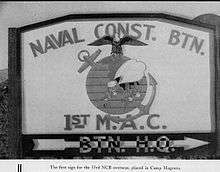

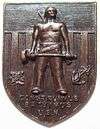
USMC historian Gordon L. Rottman wrote "that one of the biggest contributions the Navy made to the Marine Corps during WWII was the creation of the Seabees".[37] In turn, the Corps would be influential upon the CB organization and its history. In 1942 the Marines issued USMC duffel bags and uniforms to Battalions 17-20.[38][39][40] In the records of both the 18th and 19th NCBs they each claim to have been the first CB authorized to wear the USMC uniform. They both received their military training and USMC issue at Marine Training Center, New River, N.C. Marine Corps Base Camp Lejeune.[41] How many other Battalions received the USMC issue is not recorded but it is known that the 25th, 31st, 43rd,[42] 76th,[43] 121st and 133rd NCBs did also.[44] The Marine Corps listed CBs on their Table of organization: "D-Series Division" for 1942,[45] "E-Series Division" for 1943,[46][47] and "Amphibious Corps" for 1944/45[48] But, starting with the 1st Naval Construction Detachment (a.k.a. Bobcats),[14] the Marines redesignated them the 3rd Battalion 22nd Marines.[49] They were the very first Seabees and that was only the beginning. Right after them part of the 4th Naval Construction Detachment was assigned to the 5th Marine Defense Battalion on Funafuti for two years.[15] The Bureau of Yards and Docks original request of 28 December 1941 was for the authorization of three Naval Construction Battalions.[8]:Paragraph 13 When those three Battalions were formed the Seabees did not have a fully functional base of their own. So, upon leaving Navy boot camp, those men were sent to National Youth Administration camps in Illinois, New Jersey, New York and Virginia to receive military training from the Marine Corps.[1]:138
It is written that at that time the Marine Corps wanted a Seabee Battalion for each Division in the Pacific, but was told no because of war priorities.[8]:Paragraph 39 However, by autumn 1942, things changed with NCBs 18, 19 and 25[50] being assigned to Marine Divisions as combat engineers.[51] Those Battalions were posted to composite Engineer Regiments[52] and redesignated as the 3rd Battalion in their Regiment.[51] (see 16th Marine Regiment, 17th Marine Regiment[53](Fig. 8), 18th Marine Regiment,[54] 19th Marine Regiment, and 20th Marine Regiment[44]) In August 1942 C Company 18th NCB was transferred to the C.B. Replacement Group, Fleet Marine Force, San Diego. The rest of the 18th embarked from the Fleet Marine Force Base Depot, Norfolk, VA, en route to Guadalcanal where they would replace the 6th NCB with the 1st Marine Division.[55] In the fall of 1943 two sections of the 6th Special NCB were sent to the Russell Islands with the 4th Marines Advance Depot.[15] In November the 14th NCB landed with the 2nd Raider Battalion on Guadalcanal. Earlier in June the 24th NCB supported the landing of the 9th Marine Defense Battalion on Rendova.[56] The 33rd CB had 202 men posted to the 1st Pioneers as shore party to the 5th Marines of the 1st Marine Division on Peleliu. Along with them were 241 from the 73rd CB.[57] Also attached to the 1st Pioneers was the entire 17th Special NCB (segregated). The 47th sent a detachment to Enogi Inlet on Munda attached to the 1st and 4th Marine Raiders.[49] On Bougainville Commander Brockenbrough of the 71st CB was named the shore party commander for the 3rd Marine Division with his Battalion supported by elements of the 25th, 53rd, and the 75th CBs (and as well as the Marines).[58] The 75th had a 100-man detachment volunteer to land with a Company of 3rd Marines at Cape Torokina, Bougainville.[59] The 53rd also had detachments land as shore parties for the 2nd Raider Battalion on green beach and the 3rd Raider Battalion over on Puruata Island.[60](Fig. 2) The 121st was formed at NCB Training Center of the Marine Training Center - Camp Lejuene, New River, NC. There it was attached to the 4th Marine Division and assigned as the 3rd Battalion 20th Marines.[61] In 1944 the Marine Engineer Regiments were inactivated. Even with the Engineer Regiments inactivated Marine Divisions still had a CB Battalion posted to them. For Iwo Jima, the 133rd and 31st NCBs were on temporary duty assignment (TAD) to the 4th and 5th Marine Divisions. For Okinawa it was the 58th, 71st, and 145th NCBs that were TAD to the 6th, 2nd, and 1st Marine Divisions. But, going back again to Iwo Jima, there the 31st and 133rd were not re-designated. The Marines were short of Marines and the Seabees were "tasked" with the assignment. C Co 31st NCB was a component of the 5th Shore Party Regiment and was on the beach on D-day. The 31st NCB's Demolitions echelon was under divisional control through D+10 with the 5th Marine Division.[62] The 133rd was posted to the 23rd Marines as their Shore Party.[63] The Battalion had each Company detached and tasked to the assault as follows: A Co – 1/23, B Co – 2/23, C Co – 3/23, and D Co – 2/25 (see Naval Mobile Construction Battalion 133).[64]
With Iwo Jima secured the 5th Marine Division returned to Camp Tarawa where it was joined by the 116th NCB.[64] In August Japan fell and 116th NCB went with the 5th Marine Division as part of the occupation force. V-J day found thousands of Japanese troops still in China and the Third Marine Amphibious Corps was sent there to get them back to Japan. A portion of the 33rd Naval Construction Regiment was assigned to III Marine Amphibious Corps for this mission: i.e. the 83rd, 96th, 122nd CBs and the 33rd Special CB.[65][66]
As just mentioned CB Battalions were also attached to the various Amphibious Corps. The 19th NCB was assigned to the I Marine Amphibious Corps (I MAC)[55] prior to being assigned to the 17th Marines. The 53rd NCB was first posted to I MAC and redesignated "Naval Construction Battalion 1st M.A.C.(Fig. 7). Then when I MAC was redesignated III Amphibious Corps the battalion became an element of the 1st Provisional Marine Brigade[59][67] until it was disbanded 9 September 1944. For Guam, III Amphibious Corps had the 2nd Special NCB, 25th and 53rd NCBs. V Amphibious Corps (VAC) had the 23rd Special and 62nd NCBs on Iwo Jima. Back on Tinian the 6th Naval Construction Brigade incorporated VAC's insignia as a part of the Brigade's indicating the entire brigade was attached to V Amphibious Corps.[68] (the 6th Brigade was composed of: the 29th Rgt. with CBs; 18,[51] 50, 92, 107, & 135, the 30th Rgt. with CBs: 13, 67, 121,[51]& 123, and the 49th Rgt. with CBs: 9, 38, 110, & 112th (and the 27th Special).[69][70]
With the war over the Seabees ended up with the most unique standing any U.S. military component has with the U.S. Marine Corps.[71] Seabee historian William Bradford Huie wrote "that the two have a camaraderie unknown else-wheres in the United States military".[72] It should be added that even though they are "Navy" the Seabees adopted USMC fatigues with a Seabee insignia in place of the globe and anchor. During WWII a number of CBs adapted USMC insignia for their units, these included CBs 19, 25, 53, 117 and the 6th Brigade. The insignia modified were the globe and anchor, bulldog, gator with three stars, and a divisional crest.
- notes
- The 6th CB received a Presidential Unit Citation with the 1st Marine Division on Guadalcanal.[73]
- The 18th CB received a Presidential Unit Citation with the 2nd Marine Division on Tarawa[73]
- When the 18th, 19th and 25th CBs were transferred to the Marine Corps they each were reduced in size by one company plus 1/5th of Hq Co. This was done to match the organization of a USMC battalion. B Co from the 25th CB[74] and C Co from the 18th CB[75] were used in the formation of the 53rd CB. The company from the 19th NCB went towards the formation of the 121st CB.
- The 33rd and 73rd CBs shore party detachments received Presidential Unit Citations[76][73] with the 1st Marine Division on Peleliu
- The 121st CB received a Presidential Unit Citation with the 4th Marine Division on Saipan and Tinian[73]
- (Non- USMC PUC - 4oth CB plus 12 men from the 78th CB with the 1st Cavalry Division on Los Negros)[73]
- Due to the men in the CBs being given advanced rank upon enlistment, the enlisted Marines referred to Construction Battalions as "Sergeant's Battalions". USMC sergeants do not pull guard duty, so the ranked Seabees would not be assigned. The NCOs of the 18th wore USMC chevrons and not USN "crows" on their uniforms.[77]
- The 23rd Marine Regiment had Seabees as Shore Party three times: Roi-Namur, Saipan, and Iwo Jima.
Seabees were Shore Party for the Marines on Bougainville,[58] Peleliu,[57] Guam,[78] Purata Island,[59] Roi-Namur, Saipan,[79] Iwo Jima,[63] and Okinawa.[80] The Marines deployed them as combat engineers at Cape Gloucester,[81] Tarawa,[30] and Tinian.[82]
- In Australia the 1st Marine Division organized a shooting competition to demonstrate their marksmanship. It gained notoriety as the "Battle of Melbourne" with the 19th Seabees taking first prize.[83]
- The first Marines assigned to a CB were 50 men attached to Construction Detachment CBD 1010 on Guam.[84]
- This ribbon is an example of the Asiatic-Pacific Campaign Medal with the Fleet Marine Force Combat Operation Insignia (a "Restricted" device for medals and ribbons). The restrictions being: that the Naval personnel had to be under fire with the Marines and under USMC "Operational" control.[85] The Marine Corps considers this device to be a personal award. Ribbons would also have arrowheads to indicate landing in assaults and a star to indicate the campaign. Some Battalions issued award numerals instead of stars.[86]
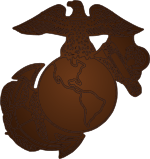

Naval Combat Demolition Units:[87] NCDUs – Underwater Demolition Teams: UDTs
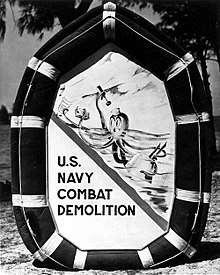
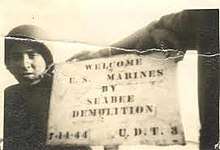

In early May 1943, a two-phase "Naval Demolition Project" was directed by the Chief of Naval Operations "to meet a present and urgent requirement". The first phase began at Amphibious Training Base (ATB) Solomons, Maryland with the establishment of Operational Naval Demolition Unit No. 1. Six Officers and eighteen enlisted men reported from NTC Camp Peary dynamiting and demolition school, for a four-week course.[31][88] Those Seabees were immediately sent to participate in the invasion of Sicily.[89] Naval Combat Demolition Units (NCDUs) consisted of one officer and five enlisted and were numbered 1–212. After that first group had been trained Lt. Commander Draper Kauffman was selected to Command the program that had been set up in Camp Peary's "Area E" close to the Seabee Dynamiting and Demolition school. Six classes were graduated from Camp Peary before the program was moved to Fort Pierce.[90] Another reason for the initial NCDU location being at Camp Peary was that the Joint Army Navy Experimental Testing(JANET) site, for beach obstacle removal Project DM-361, was located at Camp Bradford temporarily late 1942-43. Later, despite the move to Fort Pierce, Camp Peary was Kauffman's manpower source. "He would go up to Camp Peary's Dynamite School, assemble the (Seabees) in the auditorium and say, 'I need volunteers for hazardous, prolonged and distant duty."[5] Fort Pierce had Construction Battalion Unit 1011 assigned to the school. Its job was to construct and maintain the various obstacles needed for the demolitions class to practice their training. The men in those first classes referred to themselves as "Demolitioneers".[90] The NCDUs had 34 teams in England for the invasion of Normandy.(all told they suffered 53 percent casualties on Normandy).[5] While waiting for D-day the NCDUs trained with the 146th, 277th and 299th Combat Engineer Battalions.[91] Each NCDU had 5 men from a Combat Engineer Battalion attached to the team. In the beginning the first 10 NCDUs were split into 3 groups.[91] The whole thing was a bit ad-hoc as they had no Commanding Officer, but the Senior officer was the leader of group III, Lt Smith (CEC). He served in that capacity unofficially for the entire group.[91] His group III did a lot of experimental demolitions work and developed the Hagensen Pack.[91] As more teams arrived a NCDU Command was created for the invasion. With Europe invaded most of the NCDUs were sent to Fort Pierce and integrated into the UDTs for the Pacific campaign. However, 30 NCDUs[92] were also sent to the Pacific with NCDUs 1–10 staged at Turner City, Florida Island in the Solomons during January 1944.[93] A few were temporarily attached to UDTs.[93] Later NCDUs 1–10 were combined to form Underwater Demolition Team Able.[93] This team was disbanded with NCDUs 2 and 3 plus three others assigned to MacArthur's 7th Amphibious force and were the only NCDUs remaining at the war's end. The other men from Team Able were assigned to numeric UDTs.
- Naval Combat Demolition Force O was awarded the Presidential Unit Citation (United States)(Fig. 12) while Naval Combat Demolition Force U was awarded a Navy Unit Commendation for Omaha and Utah beaches at Normandy.
- The NCDUs at Normandy were numbers: 11, 22-30, 41-46, 127-8, 130-42[91]
In November 1943 the Navy learned a hard lesson with the invasion of Tarawa. Admiral Kelly Turner ordered the formation of nine Underwater Demolition Teams. UDTs 1 & 2 were completely Seabees according to the UDT Archives[94] with Seabees making up the vast majority of the men in teams 1–9 and 13 (typically referred to as the Seabee Teams).[95] Seabees were roughly 20% of UDT 11.[95] The officers were mostly CEC.[96] The first Underwater Demolition Team commander was Cmdr. E.D. Brewster (CEC) UDT 1. When Teams 1 and 2 were initially formed they were "provisional" with 180 men total.[97] The teams wore fatigues with life-vests and were not expected to leave their boats similar to the NCDUs. However, at Kwajalein Fort Pierce protocol was changed. Admiral Turner ordered daylight reconnaissance, and CEC Ens. Lewis F. Luehrs and Seabee Chief Bill Acheson wore swim trunks under their fatigues. They stripped down, spent 45 minutes in the water in broad daylight. When they got out were taken directly to Admiral Turner's flagship, still in their trunks, to report. Admiral Turner concluded that daylight reconnaissance by individual swimmers was the way to get accurate information on coral and underwater obstacles for upcoming landings. This is what he reported to Admiral Nimitz.[98] The success of those UDT 1 Seabees not following Fort Pierce protocol rewrote the UDT mission model and training regimen.[99] Ensign Luehrs and Chief Acheson were each awarded a Silver Star for their exploit.[100] As a result of UDT 1. the Naval Combat Demolition Training & Experimental Base was created at Kihei, Hawaii on Maui and was distinctly different from Fort Pierce. The first head of training was Seabee Lt. T.C. Crist, first Commander of UDT 2 (Roi-Namur and awarded silver star for there). He was in that position for a very short time before being named Commander of UDT 3(Fig 11). The actions of seabees Luehrs and Acheson created the image of UDTs as the "naked warriors". Later, UDT 13 would be on the beach at Iwo Jima. They scouted prior to D-day, helped direct the first landing craft to the correct beaches on D-day and helped clear the beaches of debris on D-plus 2. UDT 14 was the first all Fleet team, the first of three from the Pacific fleet. After July 1944 new UDTs were completely USN with no Army or USMC. At wars end 34 teams had been formed with teams 1-21 actually being deployed. The Seabees provided half of the men in the teams that saw service.
- note: UDT 3 at formation, officer composition: 11 CEC, 4 USN, 1 USMC[95]
- note: UDT 7's officers went through "indoctrination" in "Area E" at Camp Peary.[95]
- note: UDT 9 was created by combining 14 NCDUs- almost completely Seabees[95]
The Seabees were officially organized in the Naval Reserve on 31 December 1947. With the general demobilization following the war, the Naval Construction Battalions (NCBs) were reduced to 3,300 men on active duty by 1950.[101] Between 1949 and 1953, Naval Construction Battalions were organized into two types of units: Amphibious Construction Battalions (ACBs) and Mobile Construction Battalions (MCBs), which were later re-designated Naval Mobile Construction Battalions (NMCBs) in 1968.
African American Service: the Seabee stevedores
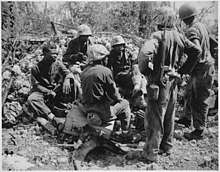
In February 1942 CNO Admiral Harold Rainsford Stark recommended African Americans for ratings in the construction trades. In April the Navy announced it would enlist African Americans in the Seabees. Even so, there were just two regular CBs that were segregated units, the 34th[103] and 80th[104] NCBs. Both had white Southern officers and black enlisted. Both battalions experienced problems with that arrangement that led to the replacement of the officers.
The Navy had a huge need for cargo handlers.[105] The lack of stevedores for unloading ships in combat zones was creating a problem. On 18 September 1942 authorization was granted for the formation of a different type of CB denoted by the tag "Special" for cargo handling.[105] By wars end 41 Special Construction Battalions were commissioned of which 15 were segregated. Those Special CBs later became the first fully integrated units in the U.S. Navy.[106] The wars end also brought the decommissioning of every one of those units. The Navy's contemporary version of these units are Navy Cargo Handling Battalions of the Navy Expeditionary Logistics Support Group (United States).
Of particular note were the actions of the 17th Special at Peleliu 15-18 Sept 1944 (Fig. 13). The Japanese mounted a counter-attack 0200 D-day nite. By the time it was over nearly the entire 17th had volunteered to hump ammo to the front lines, bring wounded back, fill where in where the wounded had been and man 37mm that had lost their crews. C Co 1st Battalion 7th Marines was hit hardest that night and was very much in need of the 17ths support. The 17th remained with the 7th Marines until the right flank had been secured D-plus3.[57][107][108][109][110][111] According to the Military History Encyclopedia on the Web, were it not for the "Black Marine shore party personal" the counterattack on the 7th Marines would not have been repulsed.[112]
Seabee North Slope Oil Exploration 1944
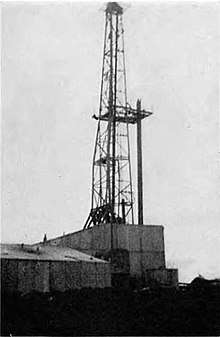
A Construction Battalion Detachment (CBD) was formed from "screening Camp Peary and the NCF for geologists, petroleum engineers, driller (oil), tool pushers, roustabouts and roughnecks" and later designated 1058.[115] [116] The officers were chosen for their arctic experience with CB 12 and CB 66.[115] Once chosen the detachment was assembled at Camp Lee Stephenson. The plan in 1944 had been to send them to the recaptured Oil fields of New Guinea with the assignment to get those fields back in production.[116] This changed when Congress earmarked $1,000,000 for Operation Pet 4 and it was decided to send them to Alaska to determine if there was actually oil in NPR 4 (U.S. Navy Petroleum Reserve No. 4), an area that had been set aside in the oil reserve 20 years earlier.[115] The area is known today as the National Petroleum Reserve in Alaska. The Detachment's mission was: to do a detailed geologic study, do core hole drilling, do deep well drilling, as well as do aerial and overland pipeline surveys.[115] In 1944 a base camp was constructed a Point Barrow. During the summer of 1945 the Seabees drilled a 2000 foot wildcat designated Seabee 1 (wildcat wells)[117] before being shut down by the cold. The well site was near 3 petroleum seepages in the Umiat area in the very south-east of NPR 4.[115] The rock in the area was from the Upper Cretaceous and has been named the "Seabee Formation".[118] In 1946 civilians took over for the Seabees some of whom had been members of CBD 1058 and were hired immediately upon discharge to continue in the same job they had performed for the Navy."[118] The Navy drew upon the cold weather experience it learned from CBD 1058 and applied it in Operation Highjump and Operation Deep Freeze.
NCF made permanent USN component
"On 13 February 1945: Chief of Naval Operations Fleet Admiral Ernest J. King approved the retention of construction battalions as a permanent and integral part of the postwar Navy. When originally established in the Second World War, the Seabee organization was meant to be only a wartime expedient."[119] By Wars end that expedient had grown to 325,000 men, roughly half the size of the Marine Corps 669,000.
- Complete listing of all WWII Seabee units found at Budocks[120]
WWII Cold War interlude - Siberia
When the Japanese signed the surrendered CB 114 was in the Aleutians. In September 1945 the battalion was ordered to send a detachment to the USSR to build a Naval Advance Base (a Fleet Weather Central).[121] It was located 10 miles outside Petropavlovsk-Kamchatsky on the Kamchatka Peninsula and code named MOKO.[122] The original agreement gave the Seabees 3 weeks to complete the camp. Upon arrival the Russians told the Seabees they had 10 days and were amazed that the Seabees did it.[122] It was one of two that Stalin agreed to. The other was near Khabarousk, Siberia in buildings provided by the Russians.[122] For mail Petropavlovsk was assigned Navy number 1169, FPO San Francisco.[123]
Cold War: Operation Crossroads
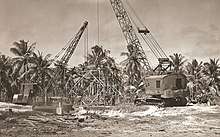
In early 1946 the 53rd NCB was still attached to III Marine Amphibious Corps[124] and was deployed for the preparations of the nuclear testing at Bikini Atoll as a component of Operation Crossroads.[125] At Bikini the battalion was assigned to Task Group 1.8 and designated TU 1.8.6.[126] On 3 August the battalion was decommissioned with the men transferred to CBD 1156 that was commissioned on Bikini.[127] The TU 1.8.6 designation continued with them. The Battalion remained on the atoll for nine days after the second nuclear test when it was detached from the Marine Corps and deactivated there.[128][129]
UDT 3 was designated TU 1.1.3 for the operation. On 27 April 1946, 7 officers and 51 enlisted embarked the USS Begor(APD-127) at the Seabee's base, Port Hueneme, for transit to Bikini.[130] Afterwards in 1948 the displaced natives put in a request to the U.S.Navy to blast a channel for access to the island Kili they had been relocated on. This was given to the Seabee detachment on Kwajelin who placed a request for UDT 3. The King of the Bikinians was so pleased he held a going-away feast for the UDTs.
Cold War: Korea
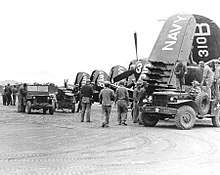
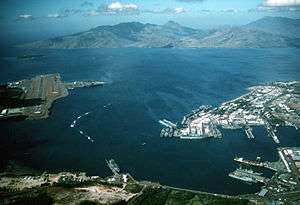
In June 1950 Seabee strength had dropped to 2,800. That changed with the outbreak of the Korean War which led to a call-up of more than 10,000 men. The expansion of the Seabees came from the Naval Reserve Seabee program where individuals volunteered for active duty. The Seabees landed at Inchon with the assault troops. They fought enormous tides as well as enemy fire and provided causeways within hours of the initial landings. Their action here and at other landings emphasized the role of the Seabees (Fig. 14). When the truce was declared there was no Seabee demobilization as there had been at the end of WWII.
During the Korean War, the Navy realized they needed a naval air station in this region. Cubi Point in the Philippines was selected, and civilian contractors were initially selected for the project. After seeing the forbidding Zambales Mountains and the maze of jungle, they claimed it could not be done. The Navy then turned to the Seabees. The first Seabees to arrive were Naval Mobile Construction Battalion Three (MCB 3) on 2 October 1951; followed by MCB 5 on 5 November 1951. Over the next five years, MCBs 2, 7, 9, 11 and 13 also deployed to Cubi Point. Seabees leveled a mountain to make way for a nearly two-mile-long runway. NAS Cubi Point turned out to be one of the largest earth-moving projects in the world, equivalent to the construction of the Panama Canal (Fig. 15). Seabees there moved 20 million cubic yards of dry fill plus another 15 million that was hydraulic fill. The $100 million facility was commissioned on 25 July 1956, and comprised an air station and an adjacent pier that was capable of docking the Navy's largest carriers. Adjusted for inflation, today's price-tag for what the Seabees built at Cubi Point would be $906,871,323.53. (that excludes the rest of the U.S.Naval Base at Subic Bay).
During the Korean War the Service School Command U.S.N.T.C. Great Lakes, Il. was the location of the U.S. Naval School Construction Battalion Reserve.[132]
Seabee Teams also called Civic Action Teams or CAT[133][134]
A product of the Cold War, Seabee Teams were an idea of the U.S. State Department for making "good use" of the Seabees. They could be sent as "U.S. Good Will Ambassadors" to third world nations as a means to combat the spread of Communism and promote "good Will", a military version of the Peace Corps. These 13 man teams would construct schools, drill wells or build clinics creating a positive image or rapport for the U.S. in the developing world. They were utilized by the United States Agency for International Development and were in S.E. Asia by the mid 1950s. Then in the early sixties the U.S.Army Special Forces were being sent into rural areas of South Vietnam to develop a self-defense force to counter the Communist threat and making use of the Seabee teams at these same places made perfect sense[135] to the CIA. So twelve "Seabee teams with Secret Clearances were sent to Vietnam to assist the U.S. Army's Special Forces in the CIA funded Civilian Irregular Defense Group program (CIDG)"[136][137] in the years 1963,64,65. By 1965 the U.S. Army had enough engineers in theater to end the Seabees involvement with the Special Forces At first they were called Seabee Technical Assistance Teams STAT. Teams after STAT 1104 were renamed Seabee Teams. In total 128 teams were sent to Vietnam[137] with STAT 1104 being the most decorated group of Seabees ever. As a group the Seabee Teams received many awards for heroism.[138] While Vietnam went on the teams were still being sent to other nations. The Royal Thai government requested STATs in 1963 and since then nearly every time a CB has left the United States for a deployment a Seabee team has been sent somewhere.
Construction Civic Action Details or CCAD[133]

CCADs or "See-Kads" are larger civic action units of 20–25 Seabees[139] with the same purpose as Seabee Teams (Fig. 16). The CCAD designation is not found in the record prior to 2013 and there is no explanation stating why these construction crews are called "details" and not "detachments".
- Commander Naval Construction Battalion U.S. Pacific Fleet, Tân Sơn Nhất, Republic of Vietnam, Completion Report 1963-1972.
- A BRIEF HISTORY OF USOM SUPPORT TO THE OFFICE OF ACCELERATED RURAL DEVELOPMENT, Prepared by USOM Office of Field Operations, James W. Dawson, AssistantProgramOfficer, September, 1969

Cold War: Antarctica
Operation Highjump
In January 1947 166 Seabees sailed from Port Hueneme, California for Antarctica as a component of Operation Highjump. They were part of Admiral Richard E. Byrd's Antarctic expedition. The Admiral was "used" for his name recognition.[140] The U.S.Navy was in charge with "Classified" orders "to do all it could to establish a basis for a (U.S.) land claim in Antarctica".[140] The Navy sent the Seabees to do the job. They would build the camp known as Little America (exploration base) IV as well as a runway for aerial mapping flights.[141] This Operation was vastly larger than IGY Operation Deep Freeze that followed.[140]
Operation Deep Freeze
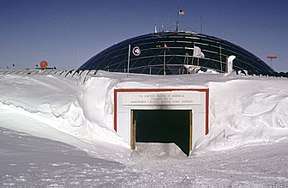

In 1955, Seabees began deploying yearly to the continent of Antarctica as participants in Operation Deep Freeze. Their mission was to build and expand scientific bases located on the frozen continent and further establish a land claim for the U.S.(Fig. 19). The first "wintering over" party included 200 Seabees who distinguished themselves by constructing a 6,000-foot (1,800 m) ice runway on McMurdo Sound. Despite a blizzard that undid the entire project, the airstrip was completed in time for the advance party of Deep Freeze II to become the first to fly into the South Pole by plane. MCB 1 was assigned for Deep Freeze II.
Over the following years and under adverse conditions, Seabees added to their list of accomplishments such things as snow-compacted roads, underground storage, laboratories, and living areas. One of the most notable achievements took place in 1962, when MCB 1 constructed Antarctica's first nuclear power plant,[143] which got them a Navy Unit Commendation. Another, in 1975, was the construction of the Buckminster Fuller Geodesic dome at Amundsen-Scott South Pole Station by NMCB 71.[144] (Fig.18) with a diameter of 164 ft (50 m) and 52 ft (16 m) high. This became a symbolic icon of the United States Antarctic Program until it was replaced (Fig. 18).
During the Cold War, the Seabees undertook a number of other missions, including constructing the Distant Early Warning Line in the Arctic. Again operating often under extreme conditions, the Seabees successfully completed every mission assigned to them.
- note: The 1972 Antarctic Treaty put the potential Cold War land claims on hold.
- note: Cold War project: 1961 floating dry dock for Polaris submarines at Holy Loch, Scotland.[145]
- note: Cold War project: 1963 U.S.Naval Communications Listening Station Nea Makri, Greece.[145]
Cold War: Vietnam
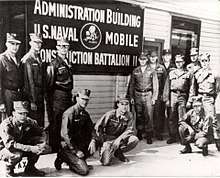
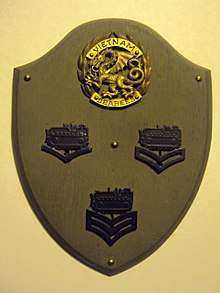
Seabees deployed to Vietnam twice in the 1950s. First in June 1954 as elements of Operation Passage to Freedom and then two years later to map and survey the nations roads. Seabee teams 501 and 502 arrived on 25 Jan 1963 and are regarded as the first Seabees of the Vietnam conflict. They were sent to Dam Pau and Tri Ton to build camps for the Special Forces.[146] In June 1965, Construction Mechanic 3rd Class Marvin G. Shields was a member of Seabee Technical Assistance Team 1104, that took part in the Battle of Dong Xoai. He was posthumously awarded the Medal of Honor for his actions there and is the only Seabee ever to be awarded the Medal of Honor. Those Seabee "Civic Action Teams" continued throughout the Vietnam War and often were fending off enemy forces alongside their Marine and Army counterparts. Teams typically built schools, clinics or drilled wells. In 1964 ACB 1 was the first CB in the theatre. Beginning in 1965 Naval Construction Regiments (NCRs) deployed throughout Vietnam. The Seabees supported the Marines by building a staggering number of aircraft-support facilities, roads, and bridges. Seabees also worked with and taught construction skills to the Vietnamese people. In 1968 the Marine Corps requested that the Navy make a name change to the CBs. The Marines were using "MCB" for Marine Corps Base and the Navy was using "MCB" for Mobile Construction Battalions. The Navy then added "Naval" to MCB creating the NMCBs that now exist. In May 1968 two reserve battalions were activated (RNMCBs 12 and 22) which brought the total number of battalions rotating to Vietnam to 21 (not including ACBs 1 and 2 or the two Construction Battalion Maintenance Units (CBMUs) that were there too). During 1969 the total number of Seabees that had deployed topped out at 29,000 and then their draw-down began.[147] The last battalion withdrew the end of 1971 which left 3 Seabee teams. They were out by at the end of 1972.
- Military training for battalions during this period lasted six weeks. The first two weeks were at home port - Davisville Naval Construction Battalion Center, CBC Gulfport or CBC Port Hueneme. The last four weeks were with the Marines at Camp Lejuene or Marine Corps Base Camp Pendleton.
- Detachments from MCBs 5, 10, 53 and CBMU 301 received Presidential Unit Citations for supporting the 26th Marines during the 11 week Battle of Khe Sanh Jan-Feb 1968.[146]
Uniform variations
During the Vietnam conflict there were a couple of uniform variations of note. Across the back of the field jacket M-65 the unit number would be stenciled between the shoulders e.g. MCB 1.[148] Another variation was the collar and cover devices for E4 – E6 enlisted (Fig. 21). The Navy authorized that the "crow" for the construction group be replaced by the rating insignia for each trade. These devices were made in gold and black (subdued).
Cold War: Naval Support Unit: Department of State
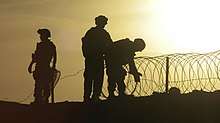
Seabees were first assigned to the State Department in 1964 because listening devices were found in the Embassy of the United States in Moscow.[150] The U.S. had just constructed a new embassy in Warsaw and Seabees were dispatched to check that one out and found lots of "bugs". This led to the creation of the support unit in 1966.[151] There are a limited number of special billets for select senior NCOs, E-5 and above. These Seabees are assigned to the Department of State and attached to Diplomatic Security.[152][150] Those chosen can be assigned individually or be part of a regional team traveling from one embassy to the next. Duties include the installation of alarm systems, CCTV cameras, electromagnetic locks, safes, vehicle barriers, and securing compounds(Fig. 22). They can also assist with the security engineering in sweeping embassies (electronic counter-intelligence). They are tasked with new construction or renovations in security sensitive areas and supervise private contractors in non-sensitive areas.[153] Due to Diplomatic protocol the Support Unit is required to wear civilian clothes most of the time they are on duty and receive a supplemental clothing allowance for this. The information regarding this assignment is very scant, but State Department records in 1985 indicate Department security had 800 employees, plus 1,200 Marines and 115 Seabees.[154] That Seabee number is roughly the same today.[155]
- In 1977 the U.S. Embassy in Moscow suffered a serve fire prompting the construction of a new one in 1979. During the fire 4 KGB entered the upper floors of the Embassy wearing fireman gear. All the while they were being watched by 4 Seabees also attired in firemans gear.[156] At the construction site of the new embassy twenty to thirty Seabees were assigned to oversee 800 plus Russian construction workers.[157] This prompted the Russians to embed bugs in construction materials prior to delivery to the construction site. The success of the KGB in bugging the new embassy only reinforced the State Departaments need for the Seabees.
- see MILPERSMAN 1306-900[158]
- see MILPERSMAN 1306-914:[159]
Cold War: Tektite I

On 28 January 1969 a detachment of 50 men[160] from Amphibious Construction Battalion 2 augmented by an additional 17 Seabee divers from both the Atlantic and Pacific fleets as well as the 21st NCR began the installation of the Tektite habitat in Great Lameshur Bay at Lameshur, U.S. Virgin Islands.[161] The Tektite program was funded by NASA and was the first scientists-in-the-sea program sponsored by the U.S. government.[162](Fig. 23). The Seabees also constructed a 12-hut base camp at Viers that is used today as the Virgin Islands Environmental Resource Station.[163] The Tektite project was a product of the Cold War and caused the U.S. Navy to realize it needed a permanent Underwater Construction capability. "It was this project that led to the formation the Seabee Underwater Construction Teams".[164]
Cold War winds down
As the Cold War wound down, new challenges were presented by the increased incidence of terrorism. There were also ongoing support missions to Diego Garcia, Guam, Okinawa, Navy and Marine Bases in Japan, the Philippines, Puerto Rico, Guantanamo Bay, Guatemala, the Naval Support Facility for Polaris and Poseidon submarines in Holy Loch, Scotland, Rota, Spain, Naples, Italy, and Souda Bay, Crete. In 1971, the Seabees began their second huge peacetime construction on Diego Garcia, a small atoll in the Indian Ocean. This project began in 1971 and was completed in 1987 at a cost of $200 million. Because of the extended time-frame, it is difficult to inflation-adjust that cost into today's dollars. The complex accommodates the Navy's largest ships and cargo planes. This base proved invaluable when Iraq invaded Kuwait in August 1990 and Operations Desert Shield and Desert Storm were launched.
Seabee construction efforts led to the expansion and improvement of Naval Air Facility, Sigonella, Sicily, turning this into a major base for the United States Sixth Fleet aviation activities.
There were combat roles as well. In 1983, a truck bomb demolished the barracks the Marines had secured in Beirut, Lebanon. After moving to the Beirut International Airport and setting up quarters there, Druse militia artillery began harassing the Marines. After consultations with the theater commander, Marine amphibious command and combat engineers, the forward-deployed battalion, NMCB-1 in Rota, Spain, sent in a 70-man AirDet working party with heavy equipment. Construction of artillery-resistant quarters went on from December 1983 until the Marines' withdrawal in February 1984. Only one casualty occurred when an equipment operator using a bulldozer to clear fields of fire was wounded by an RPG attack. Seabee EO2 Kirt May received the first Purple Heart awarded to a Seabee since Vietnam.
Robert Stethem was murdered by the Lebanese Shia militia Hezbollah when they hijacked TWA Flight 847 in 1985. Stethem was a Steelworker Second Class (SW2), a Seabee diver and member of Underwater Construction Team One. The USS Stethem (DDG-63) is named in his honor. On 24 August 2010, on board USS Stethem in Yokosuka, Kanagawa, Japan, Stethem was posthumously made an honorary Master Chief Constructionman (CUCM) by the Master Chief Petty Officer of the Navy and awarded the Prisoner of War Medal.
Persian Gulf War
During the Persian Gulf War, more than 5,000 Seabees (4,000 active and 1,000 reservists) served in the Middle East. In Saudi Arabia, Seabees built ten camps for more than 42,000 personnel; fourteen galleys capable of feeding 75,000 people; and 6 million ft² (600,000 m²) of aircraft parking apron and runways as well as over 200 helicopter landing zones. They built and maintained two 500-bed Fleet Hospitals near the port city of Al-Jubayl. Initially deployed was Battalion 7 from deployment at Camp Shields, Okinawa in September 1990. In November, battalion 74 from homeport rotation at Gulfport, Mississippi replaced NMCB7 at their interim deployment site on the island of Bahrain.
In December 1990 NMCB74 moved entirely from Bahrain, crossing by causeway to Saudi Arabia and turned North along the coast for approximately 300 kilometers. A desert camp was constructed at Ras Al Mishab, near the Kuwaiti border, and named "Camp Nomad". It was from this camp NMCB74 based its operations. One 'client' of this battalion's services was Marine Air Group 26. Many other clients enjoyed services.
NMCB74 was involved in Operation Troy, a deceptive maneuver intended to assure the Iraqi's the American main thrust would be from the Southern Kuwaiti border. NMCB74's internal name for it's participating element was "Detachment Black". Det Black constructed mock tanks, tube artillery, and manned these mock emplacements.
RNMCB24, a reserve battalion, was based at Al Jubail industrial city. This battalion served units in its area and provided rear echelon support for forward deployed NMCB74 at Mishab. Regular supply runs linked the two battalions along the MSR which ran north/south along the coast.
Iraq, Afghanistan, and the War on Terror
_helps_to_guard_his_convoy_as_it_travels_through_Al_Hillah_in_support_of_Operation_Iraqi_Freedo.jpg)
Seabees continue to provide critical construction skills in connection with the effort to rebuild the infrastructure of Afghanistan. All active and reserve Naval Mobile Construction Battalions (NMCBs) and Naval Construction Regiments (NCRs) have been deployed to both Iraq and Afghanistan. The Seabees have been deployed since the beginning of the invasion of Afghanistan in 2001 and Iraq in 2003. One of their most high-profile tasks in Iraq has been the removal of statues of Saddam Hussein in Baghdad. In Afghanistan, the Seabees' main task has been the construction of multiple forward operating bases for U.S. and coalition forces.
Since 2002, Seabees have provided critical and tactical construction skills in an effort to win the hearts and minds of locals in the Philippines. Their efforts have begun to deter the rising influence of radical terrorists in the southern Philippines, most notably the Abu Sayyaf's jungle training area. Seabees work along with Army, Marines, and Air Force under Joint Special Operations Task Force-Philippines.
Disaster relief and recovery
%2C_attached_to_Combined_Joint_Task_Force_Horn_of_Africa_(CJTF_HOA)%2C_set_up_tents.jpg)
- Hurricane Camille in 1969 made landfall 20 miles west of Naval Construction Battalion Center (Gulfport, Mississippi), NMCB-121 was in home port then, and was called upon for cleanup, rescue, and community outreach for months to come. They fed displaced families and supported the community.
- Cyclone Ofa in 1990 - NMCB 133 sent a 100-man detachment to American Samoa to aid in the recovery.
- 1994 Northridge earthquake, Seabees supported disaster recovery efforts for victims.
- Hurricane Andrew in 1992, Seabees were called on to provide recovery assistance for Homestead, Florida.
- Operation Restore Hope 1992–1993 Seabees were vital to the humanitarian efforts in Somalia sending two Battalions.[165]
- Operation Sea Signal 1994 Seabees were called to provide assistance to the Haitian Relief effort at Guantanamo Bay Naval Base, Cuba.
- Operation Joint Endeavor On Christmas Day 1995, Seabees arrived in Croatia to support the Army by building camps as part of the peacekeeping effort in Sarajevo, Bosnia and Herzegovina. NMCB 40 played a pivotal role serving with the U.S. Army 1st Infantry Division "The Big Red One", in assisting with the dismantling of forward operating bases during the IFOR/SFOR phase.
- Hurricane Georges (Sept 1998) plowed through the Caribbean Islands, causing millions of dollars in damage, and generating thousands of disaster recovery team (DRT) man-hours for the Seabees. The Navy provided generators and water trucks that were taken to nearby cities, and damage assessment teams were sent to the local islands.
- Hurricane Mitch The Seabees immediately turned their focus towards Mitch which was the most powerful hurricane of the 1998 season. Mitch left more than 17,000 people dead due to the high winds and heavy rains, which led to mudflows that buried thousands in Central America. The Seabees deployed to Honduras, participating in operations with Joint Task Force Bravo, providing capabilities to conduct engineer reconnaissance, repair roads and bridges, clear debris, remove bridges, and build base camps. NMCB 7 was the first Navy element to arrive in Central America, taking part in their second humanitarian mission on the deployment.
- Hurricane Ivan Seabees deployed in September 2004 in response to destruction to the Naval Air Station Pensacola in Florida. The Seabees cleared hurricane debris, repaired roads, erected tents, and otherwise assisted fellow service members. NMCBs 1 & 74
- Typhoon Nanmadol (2004) NMCB 7
- 2004 Indian Ocean earthquake and tsunami NMCBs 7, 40 and Underwater Construction Team (UCT) 2
- Joint Task Force Katrina 2005. Seabees from NMCBs 1, 7, 18, 40 and 133 plus ACB 2 and CBMUs 202 and 303 and UCT 1 were tasked to rebuilding CBC Gulfport and the recovery of the Gulf Coast of the United States[166]
- 2010 Haiti earthquake Seabees of NMCB 7 deployed to provide construction support and disaster relief to Haiti as did Seabee divers from Underwater Construction Team One, ACB-2 and the Army Engineer divers. They made repairs to the heavily damaged port facilities in Port-au-Prince, enabling the re-opening of the port for humanitarian supplies reach the country.
- April 2011 Miyagi earthquake Seabees from NMCB-133 and Underwater Construction Team Two deployed to Japan as part of the relief effort after the earthquake and tsunami. 2011 Tōhoku earthquake and tsunami
- Seabees of NMCB 11 Air Detachment deployed for roughly two weeks to support federal, state, and local authorities in disaster recovery operations in the New Jersey and New York areas affected by Hurricane Sandy. The Air Detachment mounted out 90 personnel and 94 pieces of civil engineering support equipment including front-end loaders, backhoes, pumps, electric generators, storage containers, and other equipment which was convoyed to the disaster area.[167] 110 Seabees from NMCB 5 were also deployed to assist in disaster relief efforts, performing vital utilities work and clearing roads and debris throughout the Sandy Hook area.[168]
Logo and unit insignias
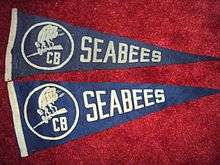
On 1 March 1942 the Chief of BuDocks recommended that as a means to promote esprit de corps in the new branch of construction battalions, that an insignia be created for use on equipment similar to what air squadrons used on their aircraft(Fig. 26). This was not something for the uniform.[1]:136 Frank J. Iafrate, a civilian plan file clerk at Quonset Point Advance Naval Base, Davisville, Rhode Island, was the artist who designed the original "Disney Style" Seabee in early 1942 with a large capital letter Q around the edge as border. This design was sent to Admiral Moreell who made a single request: that this reference to Quonset Point be changed to a hawser rope and it would be officially adopted.[169] That design remains in use to this day, predominantly unchanged. In late 1942, after designing the logo, Iafrate enlisted in the Seabees.[170] The Camp Post exchanges (PXs) sold pennants with a different Seabee design on them, that was stylistically similar to the Mosquito boat rating insignia.
The Seabees also had a second Logo that much less has been written about(Fig. 9). It was that of a shirtless construction worker holding a sledge hammer with a rifle strapped across his back standing upon the words "Construimus Batuimus USN". The figure is typically on a shield with a blue field across the top and vertical red and white stripes. A small CEC logo is left of the figure and a small anchor is to the right. The Camp's PXs sold two versions of brass badges with this logo, enameled or non-enameled. Despite little being written about this logo it is incorporated into many CB Unit insignias (or variations of it). A partial list of these CBs would be: 9, 15, 17, 23, 29, 41, 45, 50, 68, 75, 77, 86, 87, 90, 93, 95, 99, 145 & 18th Special, Construction Battalion Units (CBUs) 408, 504, 535 and the 7th Brigade.[171] Other units simply used it like 133 NCB did on the front cover of their unit history the "Rain Makers Log".[172]
During World War II, artists working for Walt Disney in the Insignia Department designed logos for about ten Naval Construction units, including the 60th NCB,[173] the 78th NCB[173] the 112th NCB[174] and the 133rd NCB[172] Good candidates, though unknown, are the logos of the 1st NCB,[68] 53rd NCB,[175] 615th CBMU,[68] 30th Regiment[176] and the 6th Brigade[68] There are two Seabee logos in the book on WWII Disney insignia entitled "Disney Don's Dogtags" that are not identified with any unit. Disney did not create the original Seabee insignia.
- Seabees sponsored many B 29s on Tinian tagging the aircraft with Seabee unit insignia as nose art.[177][178][179]
- WWII CB Unit Logos
The end of WWII brought the decommissioning of nearly every Seabee Battalion. The Construction Battalions had been in existence less than four years when this happened and the Navy had not created a Historical Branch or Archive for the NCF. So, there was no central record of the Seabees History or archive for the insignia of the individual units. As history passed, first with Korea and them Vietnam, Construction Battalions were reactivated with the units having no idea what the WWII insignia had been so they made new ones, NMCB One has had three. NMCB 8 is the exception. That Battalion has an insignia very similar to what it had during WWII.
Support of Naval Special Warfare (SEAL Teams)
A small number of Seabees support Navy Special Warfare (NSW) units based out of Coronado, CA, and Virginia Beach, VA. Seabees provide services such as power generation/distribution, logistical movement, vehicle repair, construction and maintenance of encampments, water facilities and purification.[180][181][182][183][184] Seabees assigned to support NSW receive extra training in first aid, small arms, driving, and specialized equipment.[180][182] The Seabees assigned to NSW are expected to qualify as Expeditionary Warfare Specialists.[185][186] If desired or required by the unit, Seabees assigned to NSW are eligible to receive the following Naval Enlisted Classifications upon filling the requirements: 5306 – Naval Special Warfare (Combat Service Support) or 5307 – Naval Special Warfare (Combat Support).[187] They also can apply for selection to support the NSW Development Group.[188]
NCF nomenclature

Battalion
The battalion is the fundamental unit of the Naval Construction Force (NCF). Seabee battalions are constituted in such a way as to be self-sustaining in the field. The nomenclature for NCF battalions has evolved over the years. During World War II, there were more than 140 battalions commissioned[15](fig. 27). Since then, battalions have been activated and deactivated using WWII unit numbers. Detachment: This is a construction crew that is sent to smaller construction projects "detached" from the main body's deployment site. They tend to be self-contained construction units capable of independently completing the assigned project.
- 1942 to 1949: Naval Construction Battalion (NCB)
- 1949 to 1964: Mobile Construction Battalion (MCB)
- 1964 to present: Naval Mobile Construction Battalion (NMCB)
From the early 1960s through 1991, reserve battalions were designated as Reserve Naval Mobile Construction Battalions (RNMCBs). After 1991, the word "reserve" was dropped, signifying the integration of reserve units with the active units of the NCF.
Regiment
During the rapid build-up of the Seabees during World War II, the number of battalions in a given area increased and larger construction programs were undertaken.
This necessitated a higher command echelon to plan, coordinate, and assign the work of several battalions in one area. As a result, Naval Construction Regiments (NCRs) were established in December 1942.[1]:136
Brigade
In April 1943, Naval Construction Brigades (NCB) were organized to coordinate the work of regiments.[1]:136
Brigades were the highest NCF command echelon, until early in the 21st Century. At that time, the last two brigades were the Second Naval Construction Brigade (2nd NCB) and the Third Naval Construction Brigade (3rd NCB). The 2nd NCB commanded Atlantic Fleet Seabee units and the 3rd NCB commanded Pacific Fleet Seabee units.
Both brigades were decommissioned in August 2002 and are no longer part of the NCF structure.
Division
Shortly after the commencement of the Global War on Terror, it was realized that a single command interface for global Seabee operations would be required. On August 9, 2002, the First Naval Construction Division (1NCD) was stood-up and commissioned at NAB Little Creek in Virginia.
Since January 2006, 1NCD has been a subordinate unit of Navy Expeditionary Combat Command (NECC). First Naval Construction Division (1NCD) was decommissioned May 31, 2013. The 1NCD staff will be integrated into NECC. Some 1NCD functions have been transferred to the newly created Naval Construction Groups (NCGs) in Gulfport, Mississippi, and Port Hueneme, California, which are now the East and West Coast community for the NCF.[189]
Specialty units
Construction Battalion Maintenance Unit (CBMU)
When first organized during World War II, these units consisted of approximately one fourth of the personnel of an NCB, and were intended to take over the maintenance of bases on which major construction had been completed.
Today, CBMU's provide public works support at Naval Support Activities, Forward Operating Bases, and Fleet Hospital/Expeditionary Medical Facilities during wartime or contingency operations. They also provide disaster recovery support to Naval Regional Commanders in CONUS.
Underwater Construction Team (UCT)
UCTs deploy worldwide to conduct underwater construction, inspection, repair, and demolition operations of ocean facilities, to include repair of battle damage. They maintain a capability to support a Fleet Marine Force amphibious assault, subsequent combat service support ashore, and self-defense for their camp and facilities under construction.
UCT1 is home ported at Virginia Beach, Virginia, while UCT2 is at Port Hueneme, California.
- see MILPERSMAN 1306-912[190]
Naval Construction Groups
In 2013, the Seabee Readiness Groups (SRGs) were decommissioned, and re-formed into Naval Construction Groups One and Two. They are regimental-level command groups, tasked with administrative and tactical control of Seabee Battalions, as well as conducting pre-deployment training of NCF units in the NCGs' respective home port locations. Currently, Naval Construction Group Two (NCG-2) is based at CBC Gulfport, and Naval Construction Group One (NCG-1) is based at CBC Port Hueneme.
Amphibious Construction Battalion (ACB)
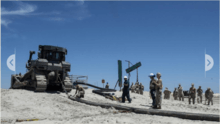
ACBs (also abbreviated as PHIBCB) evolved out of pontoon assembly battalions formed as part of the Seabees during World War II. On 31 October 1950, MCBs 104 and 105 were re-designated ACB One and ACB Two, and assigned to Naval Beach Groups.
Today, the ACBs are not part of the NCF, reporting to surface TYCOMs. Additionally, an ACB has a different personnel-mix to an NMCB, with half the enlisted personnel being traditional Seabee rates and the other half being fleet rates.
Public Works: U.S. Naval Bases
These units have CEC officers leading them and enlisted Seabees for the various crews. About one-third of new Seabees are assigned to Public Works Departments (PWD) at naval installations both within the United States and overseas. While stationed at a Public Works Department, a Seabee has the opportunity to get specialized training and extensive experience in one or more facets of their rating.
Some bases have civilians that augment the Seabees, but the department is a military organization.
Seabee Engineering Reconnaissance Teams (SERTs)
_reach_their_mission_destination_to_determine_if_an_old_bridge_can_be_used_to_support_troop_and_convoy_movements_during_an_annual_field_exercise.jpg)
Seabee Engineer Reconnaissance Teams are ten-person teams, developed during Operation Iraqi Freedom (Fig.29). SERTs are divided into three components: a liaison element, a security element and a reconnaissance element. The liaison (LNO) element has a CEC officer and two petty officers who are communications specialists. The LNO element is responsible for communications with higher echelons, both in transferring engineering assessments and intelligence and in receiving engineering reach-back solutions. The reconnaissance element has a CEC officer, who is the SERT Officer-in-Charge (OIC), a Builder or Steelworker chief petty officer who has some bridge construction experience, and petty officers of varying Seabee ratings. The OIC is normally a licensed professional engineer with a civil/structural engineering background.
A SERT unit will include a corpsman or corpsman-trained member, with the rest of the team being selected from the best of their trades in their battalion. All are qualified Seabee Combat Warfare Specialists. The UCTs proved the SERT concept was viable and they have led the way to the concept's adoption throughout OIF.[192]
NCF unit types that no longer exist
- Construction Battalion Special (stevedores)
- Construction Battalion Unit (CBU)
- Construction Detachments (CBD)
- Naval Construction Force Support Unit (NCFSU)
- Pontoon Assembly Detachments (PAD)
- Seabee Readiness Groups
Training

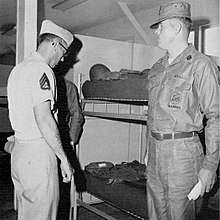
The newcomers begin "A" School (preliminary training) fresh out of boot camp, or they come from the fleet after their service term is met, spending about 75% of the twelve weeks immersed in hands-on training. The remaining 25% is spent in classroom instruction. From "A" School, new Seabees most often report to an NMCB command for their first tour of duty. For training, the new Seabees attend a four-week course of Expeditionary Combat Skills (ECS) at the Naval Construction Battalion Center in Gulfport, Mississippi, and Port Hueneme, California. ECS is also being taught to all personnel who report to a unit in the Navy Expeditionary Combat Command. ECS is a basic combat-skills course in learning map reading and land navigation, battlefield first aid, formulating defensive plans, conducting reconnaissance, and other combat-related skills. Half of each course is spent at a shooting range learning basic rifle-marksmanship and qualifying with a M16A2 or M16A3 rifle and the M9 service pistol. Those that are posted Alfa Co of an NMCB may be assigned to a crew-served weapon, such as the MK 19 40 mm grenade launcher, the M2HB .50-caliber machine gun, or the M240 machine gun. Many reserve units still field variants of the M60 machine gun. Until 2012, Seabees wore the U.S. Woodland camouflage uniform or the legacy tri-color Desert Camouflage Uniform, the last members of the entire U.S. military to do so, but have now transitioned to the Navy Working Uniform NWU Type III. Seabees use ALICE field gear, as well as some units working with Marines using USMC-issue Improved Load Bearing Equipment (ILBE) gear.
%2C_works_alongside_Marines_from_the_9th_Engineer_Support_Battalion%2C_3rd_Marine_Logi.jpg)
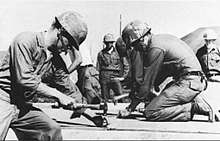
WWII training
Camp Endicott had roughly 45 different vocational schools plus additional specialized classes. These included Air compressors, Arc welding, Bridge building, Bulldozer operation, Camouflage, Carpentry, Concrete construction, Crane operation, Dam building, Deep sea diving, Diesel engines, Distillation and water purification, Dock building, Drafting, Drilling, Dry docks, Dynamite and demolition, Electricity, Electric motors, Fire fighting, Gasoline engines, Generators, Grading roads and airfields, Ice makers, Ignition systems, Lubrication, Marine engines, Marston Matting, Mosquito control, Photography, Pile driving, Pipe-fitting/plumbing, Pontoons, Power-shovel operation, Pumps, Radio, Refrigeration, Riveting, Road building, Road Scrapers, Sheet metal, Soil testing, Steelworking, Storage tanks wood or steel, Tire repair, Tractor operation, Transformers, Vulcanizing, and Well-drilling.[193]
Ratings
These indicate the construction trade in which a Seabee is skilled. During WWII, the Seabees were the highest-paid component in the U.S. Military, due to all the skilled journeymen in their ranks.
- BMB : Boatswains Mate Seabee
- CMCBB : Carpenters Mate Construction Battalion Builder
- CMCBD : Carpenters Mate Construction Battalion Draftsman
- CMCBE : Carpenters Mate Construction Battalion Excavation foreman
- CMCBS : Carpenters Mate Construction Battalion Surveyor
- EMCBC : Electricians Mate Construction Battalion Communications
- EMCBD : Electricians Mate Construction Battalion Draftsman
- EMCBG : Electricians Mate Construction Battalion General
- EMCBL : Electricians Mate Construction Battalion Line and Station
- GMCB : Gunners Mate Construction Battalion
- GMCBG : Gunners Mate Construction Battalion Armorer
- GMCBP : Gunners Mate Construction Battalion Powder-man
- MMCBE : Machinists Mate Equipment Operator
- SFCBB : Ship Fitter Construction Battalion Blacksmith
- SFCBM : Ship Fitter Construction Battalion Draftsman
- SFCBP : Ship Fitter Construction Battalion Pipe-fitter and Plumber
- SFCBR : Ship Fitter Construction Battalion Rigger
- SFCBS : Ship Fitter Construction Battalion Steelworker
- SFCBW : Ship Fitter Construction Battalion Welder
- BU : Builder
- CE : Construction Electrician
- CM : Construction Mechanic
- EA : Engineering aide
- EO : Equipment operator
- SW : Steelworker
- UT : Utilitiesman
The Seabee ranks of E-1 through E-3 use the designation "Constructionman" and wear sky-blue stripes on their dress and service uniforms. This blue was adopted in 1899 as a uniform trim color designating the Civil Engineer Corps, but was later given up. Its use by the junior enlisted is a bit of Naval Heritage in the NCF.
At E9 the ratings are reduced to three: EQCM for equipment operators and construction mechanics, CUCM for builders, steelworkers and engineering aids, UCCM for construction electricians and utilitiesmen.
Seabee Combat Warfare Insignia


The military qualification badge for the Seabees is known as the Seabee combat warfare specialist insignia (SCW)(Fig. 34). It was created in 1993 for issue to both officers and enlisted personnel that fulfill the training requirements. Only members attached to a qualifying NCF unit are eligible for the SCW pin. The qualifying units include: Naval Mobile Construction Battalions (NMCB), Amphibious Construction Battalions (ACB), Naval Construction Force Support Units (NCFSU), Underwater Construction Teams (UCT), and, since the end of 2008, Naval Construction Regiments (NCR).
The Fleet Marine Force Insignia(Fig. 35), also known as the Fleet Marine Force pin or FMF pin, are three military badges of the United States Navy which are issued to those U.S. Navy officers and sailors who are trained and qualified to perform duties in support of the United States Marine Corps. Those Seabees that draw an assignment with the Fleet Marine Force can earn the Fleet Marine Force Insignia, also known as the Fleet Marine Force pin or FMF pin. the United States Navy has authorized these badges for U.S. Navy officers and sailors who are trained and qualified to perform duties in support of the United States Marine Corps. There are currently three classes of the Fleet Marine Force pin: enlisted, officer, and chaplain. For the requirements, see: Fleet Marine Force Warfare Specialist (EFMFWS) Program per OPNAV Instruction 1414.4B.
NCF today
At present, there are six active-duty Naval Mobile Construction Battalions (NMCBs) in the United States Navy, split between the Pacific Fleet (Port Hueneme, CA) and the Atlantic Fleet (Gulfport, MS).
31st NCR – Pacific Fleet (Port Hueneme, California)[198]
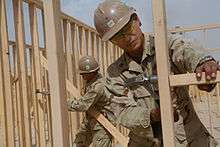
22nd NCR – Atlantic Fleet (Gulfport, Mississippi)[199]
Naval Reserve
- NMCB-14 ("Semper Fortis"): Located at Naval Construction Battalion Center Gulfport, Mississippi and consists of detachments in South Carolina, Tennessee, Georgia, Florida, Alabama, and Puerto Rico.
- NMCB-18 ("Skookum Mamook"): Headquartered at Naval Base Ventura County, California and consists of detachments in Washington, Oregon, California, Idaho, and Utah and Nevada.
- NMCB-22 ("Lone Star"): Headquartered in Port Hueneme, California. The battalion has detachments throughout Texas, Colorado, New Mexico and one in Oklahoma.
- NMCB-25 ("Spades and Clubs"): Located at Port Hueneme, CA and consists of Seabee detachments from Minnesota, Wisconsin, Illinois, North Dakota, Iowa, and Michigan.
- NMCB-27 ("Skibees"): Cold Weather Battalion, located at Westover Air Reserve Base, Chicopee, Massachusetts and includes detachments in six New England States and upstate New York.
Inactive battalions
- NMCB-2 (established 15 September 1950, decommissioned August 1956)
- NMCB-6 (established 15 April 1951, decommissioned 17 November 1969)
- NMCB-7 ("Magnificent Seven") (established 15 August 1951, decommissioned August 1970, reestablished July 1985, decommissioned 5 September 2012)
- NMCB-8 (established 10 September 1951, decommissioned 20 December 1969)
- NMCB-9 (established 15 April 1952, decommissioned 17 November 1969)
- NMCB-10 ("Men of Ten") (Originally 103 NCB (WWII unit), recommissioned 2 October 1952, decommissioned June 1976)
- NMCB-12 Headquartered at Davisville, RI (decommissioned September 1992)
- NMCB-13 Headquartered at Camp Smith (New York) (decommissioned September 1994)
- NMCB-15 ("Bat Out of Hell"): Located at Belton, Missouri. Personnel are from ten detachments in five states, (Missouri, Kansas, Iowa, Nebraska, and South Dakota). (decommissioned September 2013)
- NMCB-16 : Located at Los Alamitos, California, and consisted of detachments in California, Arizona, and Nevada. (decommissioned September 1994)
- NMCB-17 ("Desert Battalion"): Located at Fort Carson, Colorado and consists of detachments in California, Arizona, Nevada, New Mexico, Colorado, Utah and Hawaii. (decommissioned 18 September 2014)
- NMCB-20 Headquartered at Rickenbacker Air National Guard Base, Columbus, OH. (decommissioned September 1994)
- NMBC-21 ("The Blackjack Battalion"): Headquartered in Lakehurst, New Jersey and consists of detachments in New Jersey, Pennsylvania, and Delaware. (decommissioned 21 September 2013)
- NMCB-23 ("The Blue and the Gray"): Headquartered in Fort Belvoir, Virginia. (decommissioned 30 September 2013)
- NMCB-24 ("Dixie Doers") Located at Red Stone Arsenal in Huntsville, Alabama. (decommissioned 15 September 2013)
- NMCB-26 ("Packs a Punch"). Was located at Selfridge Air National Guard Base near Mt. Clemens, Michigan, and included detachments in Michigan, Ohio, Indiana, and central Illinois. (decommissioned 30 September 2014)
- NMCB-28 ("The Old Pros"): Located at Barksdale Air Force Base, Louisiana and includes detachments in Arkansas, Louisiana, Mississippi, Missouri, Oklahoma, Tennessee, and Texas. (decommissioned 2014)
- NMCB-40 ("Fighting Forty") (established 1 February 1966, decommissioned 12 September 2012)
- NMCB-53 (established 30 June 1967, disestablished 19 December 1969)
- NMCB-58 (established 15 March 1966, decommissioned 17 November 1969)
- NMCB-62 ("The Minute Men"), a.k.a. unofficially as "Sixty Screw" (established 2 July 1966, decommissioned 28 July 1989)
- NMCB-71 (established 4 October 1966, decommissioned 1 July 1975)
- NMCB-74 ("Fearless 74"), a.k.a. "Eager Beavers" in the 1980s (established 3 December 1966, decommissioned 2014)
- NMCB-121 (established 4 February 1967, decommissioned 31 August 1970)
- NMCB-128 (established 1 April 1967, decommissioned 17 November 1969)
Seabee barge carriers
_amphibious_vehicle_assigned_to_Beachmaster_Unit_One_(BMU-1)_launches_from_the_Military_Sealift_Command_(MSC)_sea_barge_heavy_lift_ship_SS_Cape_Mohican_(T.jpg)
see: Seabee (barge)
The first ship of a series of six "Sea Bee" ships,[200] was the SS Cape Mendocino (T-AKR-5064), followed by SS Cape May (T-AKR-5063) and SS Cape Mohican (T-AKR-5065)(Fig. 37), three of which were operated by Lykes Brothers Steamship Company. "The U.S. Navy’s Naval Construction Force, or SeaBees, primarily use the SEABEE barges. The barges are loaded with cargo and floated to and from a mother ship, which allows loading and unloading of containerized cargo off-shore. SEABEE barge ships are equipped with a stern cargo elevator for loading the barges from the water onto the vessel; loaded barges can then be moved toward the vessel’s bow using an internal track system. The barges are stowed on internal decks and are not stacked. The "Sea Bee" vessels had three decks and could transport 38 lighters (12 on the lower decks and 14 on the upper deck). SEABEE barges are larger and heavier than their counterpart, LASH barges."[201] The dual function of the ship is noteworthy, as it had storage tanks with a capacity of nearly 36000 m³ volume built into its sides and unusually large double hull, allowing it to be used also as a product tanker. The ships were later purchased by Military Sealift Command.
- note: Unusual Hull Design Requirements of the SEABEE Barge Carriers.[202]
Museums
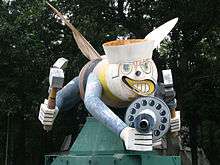
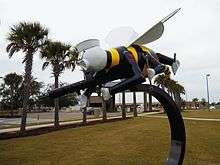
The U.S. Navy Seabee Museum[203] is located at Naval Base Ventura County, Port Hueneme, California near the entrance, but outside the main gate. Due to the location, visitors are able to visit the museum without having to enter the base proper. The museum re-opened on 22 July 2011 in a new building built by Carlsbad-based RQ Construction. The design of the single-story, 38,833 square foot structure was inspired by the Seabee Quonset hut. Inside are galleries for exhibition space, a grand hall, a theater for 45 people, collections storage, and research areas.
On 7 February 2011, the museum was certified as LEED Silver for utilizing a number of sustainable design and construction strategies. Features include the use of low-maintenance landscaping; a "cool" roofing system with high solar reflectance and thermal emittance; use of photocell-controlled light fixtures and energy-efficient lighting fixtures; 30% use of regional materials and 80% construction debris was recycled and diverted from landfills; low-volatility organic compounds (VOCs); and, use of dual-flush toilets and low-flow aerator faucets.
The Seabee Heritage Center is located in Building 446 at the Naval Construction Battalion Center. The Heritage Center is the Atlantic Coast Annex of the Seabee Museum in Port Hueneme.[204] Opened in 1995, the museum annex commemorates the history and achievements of the Atlantic Coast Naval Construction Force (Seabees) and the Navy's Civil Engineer Corps.[205] Exhibits at the Gulfport Annex are provided by the Seabee Museum in Port Hueneme.[206]
The Seabee Museum and Memorial Park[207] in Davisville, Rhode Island was opened in the late 1990s by a group of former Seabees. The Fighting Seabee Statue is located there(Fig. 39).
Notable Seabees
- Bruce Goff, architect.
- Frank J. Iafrate (created the Seabee logo)[208][209]
- Elmore Leonard, novelist and screenwriter.
- William Levitt, real-estate developer. (COMCBLANT)
- Admiral Ben Moreell[210]
- Jame F. Sasseville, Cartoonist and ghost artist for Charle's Schultz's Snoopy cartoon[211] (MCB 9)
- Marvin Glenn Shields, awarded Medal of Honor in Vietnam. (MCB 11)
- Robert Stethem, murdered during hijacking of TWA Flight 847. (UCT 1)
- Glenn Corbett, actor.
See also
- Admiral Ben Moreell
- Amphibious Construction Battalion One (ACB-1)
- Amphibious Construction Battalion TWO (ACB-2)
- Civil Engineer Corps United States Navy
- Emirau
- Seabees in World War II
- Military engineering of the United States
- Naval Mobile Construction Battalion One
- Naval Mobile Construction Battalion 3
- Naval Mobile Construction Battalion 4
- Naval Mobile Construction Battalion 7
- Naval Mobile Construction Battalion 11
- Naval Mobile Construction Battalion 25
- Naval Mobile Construction Battalion 26
- Naval Mobile Construction Battalion 40
- Naval Mobile Construction Battalion 133
- Naval Construction Battalion Center (Gulfport, Mississippi)
- Naval Construction Battalion Center Port Hueneme
- Naval Amphibious Base Little Creek
- Naval Amphibious Base Coronado
- United States Navy Seals
- Underwater Demolition Team
- United States Navy Argus Units with Acorn Units
- 16th Marine Regiment (Engineer)
- 17th Marine Regiment (Engineer) 19th NCB
- 18th Marine Regiment (Engineer) 18th NCB
- 19th Marine Regiment (Engineer) 25th NCB
- 20th Marine Regiment (Engineer) 121st NCB
Other U.S. military construction/engineering organizations:
- RED HORSE - U.S. Air Force
- United States Army Corps of Engineers
- USMC Combat Engineers List of United States Marine Corps battalions
References
- 1 2 3 4 5 6 7 "Chapter VI: The Seabees". Building the Navy's Bases in World War II: History of the Bureau of Yards and Docks and the Civil Engineer Corps 1940–1946. I. Washington, DC: United States Government Printing Office. 1947. Retrieved 18 October 2017 – via HyperWar.
- ↑ "Chapter XXIV: Bases in the South Pacific". Building the Navy's Bases in World War II: History of the Bureau of Yards and Docks and the Civil Engineer Corps 1940–1946. I. Washington, DC: United States Government Printing Office. 1947. Retrieved 18 October 2017 – via HyperWar.
- ↑ The Water is Never Cold, James Douglas O'Dell, Brassey's, 22841 Quicksilver Drive, Dulles, VA 20166, 2001, p. 28 ISBN 1574882759
- ↑ Formation 2015.
- 1 2 3 4 Training the Fighting Seabees of WWII at Camp Peary, Daily Press, E-newspaper 3 Dec, 2017, Mark St. John Erickson, 703 Mariners Row, Newport News, VA.
- ↑ "Admiral Ben Moreell, CEC, USN". Seabee Museum and Memorial Park. Retrieved 18 October 2017.
- ↑ WDTVLIVE42 (24 August 2012). "Seabees – 1945 Educational Documentary". YouTube. Retrieved 18 October 2017.
- ↑ "The Seabees". Flying. Vol. 35 no. 4. October 1944. p. 261. ISSN 0015-4806. Retrieved 18 October 2017.
- ↑ "The Twelfth Regiment (Public Works) and the Origin of the Seabees". U.S. Navy Seabee Museum. Retrieved 18 October 2017.
- 1 2 3 4 5 6 7 8 9 10 11 12 Introduction 2017.
- ↑ The Seabees would name their first Training Center for Captain Allen.
- ↑ FLAGS, PENNANTS & CUSTOMS, NTP 13 (B), NAVAL COMPUTER AND TELECOMMUNICATIONS COMMAND, 4401 MASSACHUSETTS AVE., N.W., WASHINGTON, D.C. 20394-5460, section 17.11, p.17-5
- 1 2 "Chapter IV: Bobcat". Department of the Navy Office of Naval Operations: The Logistics of Advance Bases: The Base Maintenance Division Op30 (Op415). Washington, DC: United States Government Printing Office. 1947. Retrieved 18 October 2017 – via HyperWar.
- 1 2 3 4 5 "Seabee Unit Histories" (PDF). The NMCB 62 "Minutemen". Retrieved 18 October 2017.
- 1 2 3 4 5 Formation 2017.
- ↑ Seabee Online magazine, March 4–10, Naval Facilities Engineering Command (NAVFAC), Attn: SEABEE Online (Code PA) 1322 Patterson Ave., S.E., Bldg. 33, Suite 1000, Washington Navy Yard, DC 20374-5065
- ↑ Rogers, J. David. "U.S. Navy Seabees During World War II" (PDF). Missouri University of Science and Technology. p. 8. Retrieved 18 October 2017.
- ↑ NAVFAC website, 1322 Patterson Ave. SE, Suite 1000, Washington Navy Yard, D.C. 20374-5065
- ↑ CAMP LEE-STEPHENSON MONUMENT AT QUODDY VILLAGE, EASTPORT, MAINE, CEC / Seabee Historical Foundation PO Box 657, Gulfport, MS 39502, (228) 865-0480, info@seabeehf.org
- ↑ "Chapter XXVI: Bases in the Southwest Pacific". Building the Navy's Bases in World War II: History of the Bureau of Yards and Docks and the Civil Engineer Corps 1940–1946. I. Washington, DC: United States Government Printing Office. 1947. Retrieved 18 October 2017 – via HyperWar.
- 1 2 3 "Chapter VI: Advance Base Units – Lions, Cubs, Acorns". Department of the Navy Office of Naval Operations: The Logistics of Advance Bases: The Base Maintenance Division Op30 (Op415). Washington, DC: United States Government Printing Office. 1947. Retrieved 18 October 2017 – via HyperWar.
- ↑ "Chapter XXVI: Bases in the Southwest Pacific". Building the Navy's Bases in World War II: History of the Bureau of Yards and Docks and the Civil Engineer Corps 1940–1946. I. Washington, DC: United States Government Printing Office. 1947. p. 120. Retrieved 18 October 2017.
- ↑ Blazich, Frank A. (26 November 2014). "Harbor-Base-Neighbors: When the Navy Came to Port Hueneme, 1942–1945, and Beyond". Seabees Online. Navy Facilities Engineering Command. Retrieved 18 October 2017.
- ↑ Rottman, Gordon L. (2002). World War II Pacific Island Guide: A Geo-military Study. Westport, Connecticut: Greenwood Publishing Group. p. 78. ISBN 978-0-313-31395-0. Retrieved 18 October 2017.
- ↑ Building the Navy's Bases in World War II: History of the Bureau of Yards and Docks and the Civil Engineer Corps 1940–1946. II. Washington, DC: United States Government Printing Office. 1947. p. 264. Retrieved 18 October 2017.
- ↑ "Chapter V: Procurement and Logistics for Advance Bases". Building the Navy's Bases in World War II: History of the Bureau of Yards and Docks and the Civil Engineer Corps 1940–1946. I. Washington, DC: United States Government Printing Office. 1947. Retrieved 18 October 2017 – via HyperWar.
- ↑ Rogers, J. David. "U.S. Navy Seabees During World War II" (PDF). Missouri University of Science and Technology. p. 67. Retrieved 18 October 2017.
- ↑ "Banika (and Pavuvu), Russell (or Russel) Islands". History of the 93rd Seabees Battalion. Retrieved 18 October 2017.
- 1 2 "TarawaTalk – Tarawa Seabees". DiscussionApp. 20 November 2009. Retrieved 18 October 2017.
- 1 2 Blazich, Frank A. (12 May 2017). "This Week in Seabee History (Week of May 14)". Seabees Online. Navy Facilities Engineering Command. Retrieved 18 October 2017.
- ↑ Building the Navy's Bases in World War II: History of the Bureau of Yards and Docks and the Civil Engineer Corps 1940–1946. I. Washington, DC: United States Government Printing Office. 1947. p. 130. Retrieved 18 October 2017.
- ↑ "Chapter 1: History and Organization of the Seabees and Laws of War". Seabee Combat Handbook, Volume 1. 7 May 2001. Retrieved 18 October 2017 – via engineeringtraining.tpub.com.
- ↑ Oliver, Charlotte C. (3 March 2017). "The Sting of the Bee: 75 Years of the Navy Seabee". All Hands. Defense Media Activity. Retrieved 15 March 2017.
- ↑ "Chapter XXV: Campaign in the Solomons". Building the Navy's Bases in World War II: History of the Bureau of Yards and Docks and the Civil Engineer Corps 1940–1946. II. Washington, DC: United States Government Printing Office. 1947. Retrieved 18 October 2017 – via HyperWar.
- ↑ "Chapter 5: Identification Badges/Awards/Insignia: #5319: Miscellaneous Devices". United States Navy Uniform Regulations. Navy Personnel Command. Retrieved 18 October 2017.
- ↑ Rottman, Gordon L. (2002). U.S. Marine Corps World War II Order of Battle: Ground and Air units in the Pacific War, 1939–1945. Westport, Connecticut: Greenwood Press. p. 31. ISBN 978-0-31331-906-8.
- ↑ Huie, William Bradford (1945). Can Do!: The Story of the Seabees. New York: E. P. Dutton.
- ↑ "WWII CB uniform". Weebly.com. Retrieved 18 October 2017.
- ↑ "WWII CB uniform, 1944 Leatherneck Magazine". weebly.com. Retrieved 18 October 2017.
- ↑ "Construction Battalions with the Marine Corps". Seabee Museum archive. 5 August 1942. Missing or empty
|url=(help) - ↑ "43rd Seabees Wearing USMC Uniforms – Maui, Hawaii". seabee-rvn.com. Retrieved 18 October 2017.
- ↑ "Navy Seabees in Marine Corps Service Uniform". Uniforms of World War Two. Retrieved 18 October 2017.
- 1 2 Ratomski, John J. "121st Naval Construction Battalion". World War II Stories in Their Own Words. Retrieved 18 October 2017.
- ↑ Rottman (2002), Fig. 4.2.
- ↑ Rottman (2002), Fig. 4.3.
- ↑ U.S . Marine Corps Pacific Theater of operations 1943–44, Gordon L. Rottman, Osprey Publishing, Combat Mission Chapter, Engineer Regiments Section, 2004
- ↑ Rottman (2002), Fig. 4.1.
- ↑ Ratomski, John J. "The 25th Naval Construction Battalion". World War II Stories in Their Own Words. Retrieved 18 October 2017.
- 1 2 3 4 Rottman (2002), pp. 218–220.
- ↑ Rottman, Gordon L. (2004). Battle Orders: US Marine Corps Pacific Theater of Operations 1943–44. Osprey Publishing. p. 13. ISBN 978-1-84176-659-1.
- ↑ "The 19th Battalion Seabees in Australia". Oz at War. 14 August 2007. Retrieved 18 October 2017.
- ↑ Karoly, Steven A. (2000). "A Brief History of NMCB 18". seabeecook.com. Retrieved 18 October 2017.
- 1 2 "Seabee Battalion List". seabees93.net. Retrieved 18 October 2017.
- ↑ Melson, Charles D. (14 December 2013). "The Munda Drive and the Fighting Ninth". Up The Slot: Marines in the Central Solomons. Marines in World War II Commemorative Series. CreateSpace Independent Publishing Platform. ISBN 978-1-49447-838-4. Retrieved 18 October 2017.
- 1 2 3 Ratomski, John J. "Peleliu Shore Party". Tribute to Michael A. Lazaro and all other Peleliu Veterans. Retrieved 18 October 2017.
- 1 2 71st U.S. Naval Construction Battalion. U.S. Navy Seabee Museum. p. 14.
- 1 2 3 "Seabees!". WWII Forums. Retrieved 18 October 2017.
- ↑ Home World War II OTHER WWII UNIT STORIES AND INFO webpage: Bougainville Seabees by Thurman, April 14, 2006 in OTHER WWII UNIT STORIES AND INFO
- ↑ "WWII Seabees photos". Witness to War. Retrieved 18 October 2017.
- ↑ Annex Uncle, 5th Marine Divisions Operations Report, April 1945, National Archives, College Park, Maryland.
- 1 2 "Fourth Marine Division operations report, Iwo Jima, 19 February to 16 March, 1945". Ike Skelton Combined Arms Research Library Digital Library. Retrieved 18 October 2017. Open PDFs Part 6 and Part 7 for Appendix 1 Annex Dog (Shore Party Log D-Day–D+18)
- 1 2 THE FIFTH MARINE DIVISION in WORLD WAR II, Prepared by, Lieutenant John C. Chapin, HISTORICAL DIVISION, HEADQUARTERS, U. S. MARINE CORPS, August, 1945, Appendix B,(2) Component Units
- ↑ Building the Navy's Bases in World War II: History of the Bureau of Yards and Docks and the Civil Engineer Corps 1940–1946. II. Washington, DC: United States Government Printing Office. 1947. p. 470. Retrieved 18 October 2017.
- ↑ Building the Navy's Bases in World War II: History of the Bureau of Yards and Docks and the Civil Engineer Corps 1940–1946. II. Washington, DC: United States Government Printing Office. 1947. p. 415. Retrieved 18 October 2017.
- ↑ 53rd Naval Construction Battalion: the Marine Seabee 1st M.A.C. U.S. Navy Seabee Museum. pp. 14 & 106.
- 1 2 3 4 "U.S. Navy Seabee Museum". Picssr. Retrieved 18 October 2017.
- ↑ Sixth Brigade Log: Task on Tinian. U.S. Navy Seabee Museum. p. 10. Retrieved 18 October 2017.
- ↑ "The "Seabees" on Tinian". Official 444th Bombardment Group Association. Retrieved 18 October 2017.
- ↑ Kester, Charles (January 1963). "Can Do!". Leatherneck. p. 30. Retrieved 18 October 2017.
- ↑ Third Marine Division Association (1992). Third Marine Division's Two Score and Ten History. Turner Publishing Company. p. 162. ISBN 978-1-56311-089-4. Retrieved 18 October 2017.
- 1 2 3 4 5 Naval History and Heritage Command website, Part 2 - Unit Awards, Published:Mon Aug 31 14:01:11 EDT 2015
- ↑ 25th Naval Construction Unit History, Seabee Museum Archives, Port Hueneme, CA. 93043
- ↑ 18th Naval Construction Battalion Log, date 2-8-43, Navy Seabee Museum website, Port Hueneme, CA'
- ↑ Navy and Marine Corps Awards Manual, NAVPERS 15,790 (REV. 1953)
- ↑ Huie, Willam Bradford (1945). From Omaha to Okinawa: The Story of the Seabees. New York: E. P. Dutton.
- ↑ 25th Naval Construction Battalion: Pacific Diary. U.S. Navy Seabee Museum. p. 116. Retrieved 18 October 2017.
- ↑ Crowl, Philip A. (1959). "Chapter VII: Supporting Arms and Operations". U.S. Army in World War II, The War in the Pacific, Campaign in the Marianas. U.S. Army. p. 125. Retrieved 18 October 2017.
- ↑ Nichols, Charles S. (1955). "Appendix IV". Okinawa: Victory in the Pacific. Quantico, VA: USMC Historical Section, United States Marine Corps. Retrieved 18 October 2017.
- ↑ Blazich, Frank A. (23 December 2015). "This Week in Seabee History (Week of December 20)". Seabees Online. Navy Facilities Engineering Command. Retrieved 18 October 2017.
- ↑ Rottman, Gordon L. (2002). U.S. Marine Corps World War II Order of Battle: Ground and Air units in the Pacific War, 1939–1945. Westport, Connecticut: Greenwood Press. p. 328. ISBN 978-0-31331-906-8. Retrieved 18 October 2017.
- ↑ "1st Marine Division, United States Marine Corps (USMC), "The Old Breed" in Australia during WW2". Oz at War. 10 October 2016. Retrieved 18 October 2017.
- ↑ Seabee News Service, The Bureau of Yards and Docks, 11 July 1944, p. 4
- ↑ "SECNAVINST 1650.1H: Navy & Marine Corp Awards manual" (PDF). U.S. Marine Corps. 22 August 2006. pp. 1–9. Retrieved 18 October 2017.
- ↑ "Service Ribbon Accoutrements". United States Army Institute of Heraldry. Retrieved 18 October 2017.
- ↑ "Naval Combat Demolition Unit". U.S. Naval Special Warfare Archives. Retrieved 18 October 2017.
- 1 2 Blazich, Frank A. (6 June 2014). "Opening Omaha Beach: Ensign Karnowski and NCDU-45". Seabees Online. Navy Facilities Engineering Command. Retrieved 18 October 2017.
- 1 2 "Naval Combat Demolitions Units". SpecWarNet.net. Retrieved 18 October 2017.
- 1 2 3 4 5 REPORT ON NAVAL COMBAT DEMOLITION UNITS in OPERATION "NEPTUNE" as part of TASK FORCE 122, Submitted by: Lt.(jg) H. L. Blackwell, Jr. D-V(G), USNR, 5 July 1944.
- ↑ The Water is Never Cold, James Douglas O'Dell, Brassey's, 22841 Quicksilver Drive, Dulles, VA 20166, 2001, ISBN 1574882759
- ↑ File: UDT 1 & UDT 2 Formation and History, U.S. Navy Seal Museum Archives, 3300 N Hwy A1A, Fort Pierce, FL 34949
- 1 2 3 4 5 "The Teams in World War II". View of the Rockies. Retrieved 18 October 2017.
- ↑ Blazich, Frank A. (12 September 2016). "This Week in Seabee History (Week of September 11)". Seabees Online. Navy Facilities Engineering Command. Retrieved 18 October 2017.
- ↑ "WWII UDT One & WWII UDT Two". View of the Rockies. Retrieved 18 October 2017.
- ↑ Hoyt, Edwin P. (15 June 2011). SEALs at War. Random House Publishing Group. p. 25. ISBN 978-0-307-57006-2. Retrieved 18 October 2017.
- ↑ Kelly, Orr (24 June 2014). Brave Men, Dark Waters: The Untold Story of the Navy SEALs. Open Road Media. p. 30. ISBN 978-1-4976-4563-9. Retrieved 18 October 2017.
- ↑ The Water is Never Cold, James Douglas O'Dell, Brassey's, 22841 Quicksilver Drive, Dulles, VA 20166, 2001, ISBN 1574882759 p. 136
- ↑ Between 2015.
- ↑ Antill, Peter (2003), Peleliu, battle for (Operation Stalemate II) - The Pacific War's Forgotten Battle, September–November 1944, "HITTING THE BEACH 3rd paragraph"
- ↑ Thirty Fourth Naval Construction Battalion, Cmdr Lester M. Marx, Schwabacher Frey Company, San Francisco, CA, 1946
- ↑ 80th Naval Construction Battalion, Bickford Engraving And Electrotype Co. 20 Matheewson Street, Providence, RI, 1946
- 1 2 This week in Seabee History, Sept 17- Sept 23, Seabee online Magazine, Naval Facilities Engineering Command, 1322 Patterson Ave., S.E. Bldg. 33, Suite 1000, Washington Navy Yard, DC 20374-5065
- ↑ Seabeemagazine online 2014/03/06
- ↑ "17th Special NCB cruisebook" (PDF). Naval History and Heritage Command. p. 29. Retrieved 18 October 2017.
- ↑ "Seabees of 17th Special Naval Construction Battalion Wait to Assist Wounded of 7th Marines". World War II Database. Retrieved 18 October 2017.
- ↑ "African-American Marines of 16th Field Depot Rest on Peleliu". World War II Database. Retrieved 18 October 2017.
- ↑ "17 Special Naval Construction Battalion" (PDF). Naval History and Heritage Command. Retrieved 18 October 2017.
- ↑ Princeton University Library, Marine Corps Chevron, Vol 3 Number 48, 2 December 1944
- ↑ Peleliu, battle for (Operation Stalemate II) - The Pacific War's Forgotten Battle, September–November 1944, (section: Hitting the Beach, 3rd paragraph), Military History Encyclopedia on the Web, by: Peter D Antill, Tristan Dugdale-Pointon, and Dr John Rickard,
- ↑ The Sextant, Building for a Nation and for Equality: African American Seabees in World War II – MARCH 4, 2014, Dr. Frank A. Blazich Jr., U.S. Navy Seabee Museum, Naval History and Heritage Command webpage
- ↑ Breaking Down Barriers: The 34th Naval Construction Battalion, by the Seabee Museum, Port Huemene, CA. Feb 7 2018
- 1 2 3 4 5 Exploration of Naval Petroleum Reserve No. 4 and Adjacent Areas Northern Alaska, 1944-53 Part 1, History of the Exploration By JOHN C. REED, CDR, USNR, GEOLOGICAL SURVEY PROFESSIONAL PAPER 301 Prepared and published at the request of and in cooperation with the U. S. Department of the Navy, Office of Naval Petroleum and Oil Shale Reserves, UNITED STATES GOVERNMENT PRINTING OFFICE, WASHINGTON : 1958, p.4,23
- 1 2 ComIcePac, CBD 1058, 1945, Seabee Museum, Port Hueneme , CA
- ↑ Department of the Interior U.S. Geological Survey Selected Data from Fourteen Wildcat Wells in the National Petroleum Reserve in Alaska, USGS Open File Report 00-200, Wildcat Well Seabee 1, Dept. of the Interior, U.S. Geological Survey, Central Region Energy Resources Team, P.O. Box 25046, Mail Stop 939, Denver, CO 80225-0046, ph 303-236-1647
- 1 2 Division of Geological & Geophysical Surveys PRELIMINARY INTERPRETIVE REPORT 2008-1 PRELIMINARY RESULTS OF RECENT GEOLOGIC FIELD INVESTIGATIONS IN THE BROOKS RANGE FOOTHILLS AND NORTH SLOPE, ALASKA by Marwan A. Wartes and Paul L. Decker, March 2008, Released by STATE OF ALASKA, DEPARTMENT OF NATURAL RESOURCES, Division of Geological & Geophysical Surveys, 3354 College Rd. Fairbanks, Alaska 99709-3707
- ↑ On This Date in Seabee History, Seabee Online Magazine
- ↑ Building the Navy's Bases in World War II, History of the Bureau of Yard and docks and the Civil Engineer Corps, 1940-1946, Volume II, United States Government Printing Office, Washington, 1947
- ↑ The 114th CB cruisebook, 1946, U.S.Navy Seabee Museum Archives, Port Hueneme, Ca, p.123-125
- 1 2 3 Yanks in Siberia: U.S. Navy Weather Stations in Soviet East Asia, 1945, G. Patrick March, Pacific Historical Review, Vol. 57, No. 3 (Aug., 1988), pp. 327-342, Published by: University of California Press.
- ↑ US Navy Abbreviations of World War II,The Navy Department Library, U.S. Navy web site, Published:Thu Jul 23 14:45:40 EDT 2015
- ↑ Rottman, Gordon L. (2002). U.S. Marine Corps World War II Order of Battle: Ground and Air units in the Pacific War, 1939–1945. Westport, Connecticut: Greenwood Press. p. 224. ISBN 978-0-31331-906-8.
- ↑ Building the Navy's Bases in World War II: History of the Bureau of Yards and Docks and the Civil Engineer Corps 1940–1946. II. Washington, DC: United States Government Printing Office. 1947. p. 416. Retrieved 18 October 2017.
- ↑ Naval History and Heritage Command, Naval History and Heritage Command, 805 Kidder Breese Street SE, Washington Navy Yard, DC 20374-5060
- ↑ Operations Crossroads, DNA 6032F, prepared by the Defense Nuclear Agency, p.190-91
- ↑ Rottman, Gordon L. (2002). U.S. Marine Corps World War II Order of Battle: Ground and Air units in the Pacific War, 1939–1945. Westport, Connecticut: Greenwood Press. p. 224. ISBN 978-0-31331-906-8.
- ↑ Blazich, Frank A. (30 July 2017). "This Week in Seabee History (Week of July 30 – August 5)". Seabees Online. Navy Facilities Engineering Command. Retrieved 18 October 2017.
- ↑ Operations Crossroads, DNA 6032F, prepared by the Defense Nuclear Agency, p.189
- ↑ Operation Crippled Chick, ACB 1 Builds Emergency Airstrip Behind Enemy Lines, By Steve Karoly, The seabeecook webpage
- ↑ Seabee Reserve Training Manuals 8-53, 9-54, Service School Command U.S.N.T.C. Great Lakes, Il.
- ↑ "Civil Engineers, Seabees & Bases in Vietnam", Captain Charles J. Merdinger, CEC USN, Virtual Vietnam website, Texas Tech University: The Vietnam Center and Archive
- ↑ "Seabee History: South east Asia", Naval History and Heritage Command Online reading room, published 16 Apr, 2015
- ↑ Seabee Teams in Vietnam 1963–69, Thomas A. Johnson, Createspace Independent Publishing Platform, 2010, ISBN 9781461192107
- 1 2 Commander Naval Construction Battalion U.S. Pacific Fleet, Tân Sơn Nhất, Republic of Vietnam, Completion Report 1963-1972.
- ↑ Commander Naval Construction Battalion U.S. Pacific Fleet, Tân Sơn Nhất, Republic of Vietnam, Completion Report 1963-1972. p. 4-7 /4-12
- ↑ "Building and Enduring Presence", The Military Engineer, LTJG Frances Hunter & Lt. James A. Harder (NMCB 11), Nov–Dec 2017, published by, Society of American Military Engineers, 607 Prince St. Alexandria, VA 22310
- 1 2 3 "Operation Highjump" Air & Space Magazine, July 2007, Smithsonian Institution, POB 37012, MRC 513, Washington, D.C. 20013
- ↑ Seabeemagazine Online Seabee-History-week-of-jan-17
- 1 2 Sabbatini, Mark. "Heavy duty champ turns 50". The Antarctic Sun. Retrieved 18 October 2017.
- ↑ Reid, Tyler (21 March 2014). "Nuclear Power at McMurdo Station, Antarctica". Stanford University. Retrieved 18 October 2017.
- ↑ Blazich, Frank A. (27 August 2014). "Rendezvous with Penguins: Seabee Construction of the South Pole Dome". Seabees Online. Navy Facilities Engineering Command. Retrieved 18 October 2017.
- 1 2 U.S.Navy BMR study guide
- 1 2 Seabee Online Magazine, This Week In Seabee History 14 February
- ↑ Tucker, Spencer C., ed. (20 May 2011). "Seabees". The Encyclopedia of the Vietnam War: A Political, Social, and Military History (2nd ed.). Santa Barbara, California: ABC-CLIO. p. 1023. ISBN 978-1-85109-961-0. Retrieved 18 October 2017.
- ↑ MCB 1 Cruisebook 1966, p. 57-58, Seabee Museum, Port Hueneme, CA
- ↑ U.S. Department of State Official Blog
- 1 2 This Week in Seabee History, 16 April, Seabee Online Magazine
- ↑ US Navy Basic Military Requirements for Seabees, Chapter 1
- ↑ "Protecting Information". U.S. Department of State. Retrieved 18 October 2017.
- ↑ US Navy Basic Military Requirements for Seabees, Chapter 1, p. 11
- ↑ Barker, J. Craig (24 February 2016). The Protection of Diplomatic Personnel. New York: Routledge. p. 92. ISBN 978-1-317-01879-7.
- ↑ From bugs to bombs, little-known Seabee unit protects US embassies from threats, Stars and Stripes, Published: April 26, 2018,
- ↑ The Ambassadors and America's soviet Policy, oxford University Press, 200 Madison Ave, New York, N.Y., 10016, 1995, p. 245, ISBN 0-19-506802-5
- ↑ Cleaning the Bug House, BY PETER GRIER, Air Force Magazine, SEPTEMBER 2012,
- ↑ PERS-4010G, Embassy Duty, NAVY PERSONNEL COMMAND: 5720 Integrity Drive, Millington TN 38055-0000,Address Correspondence to: Attn: PERS-### or BUPERS-### , This is an official U.S. Navy Website[ https://www.public.navy.mil/bupers-npc/reference/milpersman/1000/1300Assignment/Documents/1306-900.pdf]
- ↑ PERS-4010G, Embassy Duty, NAVY PERSONNEL COMMAND: 5720 Integrity Drive, Millington TN 38055-0000,Address Correspondence to: Attn: PERS-### or BUPERS-### , This is an official U.S. Navy Website
- ↑ All Hands, June 1969, Number 629, Per G15, BuPers, Navy Dept. Washington, DF.C. 20370, p. 39
- ↑ Seabeemagazine online Seabeemagazine online
- ↑ Underwater 360 online magazine
- ↑ St. John Historical Society, P.O. Box 1256, St. John, US Virgin Islands, 00831, Crystal Blue View of Tektite II
- ↑ U.S.Navy Seabee Museum online magazine, "Project Tektite and the Birth of the Underwater Construction Teams" by Dr. Frank A. Blazich Jr., Historian, U.S. Navy Seabee Museum
- ↑ Mroczkowski, Dennis P. (2005). "Chapter 8: Normailty Begins to Return" (PDF). Restoring Hope in Somalia with the Unified Task Force 1992–1993. Quantico, Virginia: History and Museums Division, Marine Corps University. Retrieved 18 October 2017.
- ↑ "Hurricane Relief", Seabee magazine, Winter 2006
- ↑ McAvoy, Audrey (20 November 2012). "Seabees Complete Disaster Recovery Mission". Military.com. Retrieved 19 December 2015.
- ↑ "US Navy Provides Disaster Relief in the Aftermath of Hurricane Sandy". Defense Media Activity. 11 April 2017. Retrieved 25 April 2017.
- ↑ "Origin of the SeaBee logo". Albertville 94th Battalion, U.S. Naval Sea Cadet Corps. Retrieved 18 October 2017.
- ↑ "The Fighting Bee". Seabee Museum & Memorial Park. Archived from the original on 26 December 2014. Retrieved 18 October 2017.
- ↑ "U.S. Navy Seabee Museum". Picssr. Retrieved 18 October 2017.
- 1 2 133 Naval Construction Battalion. U.S. Navy Seabee Museum. Retrieved 18 October 2017.
- 1 2 Daly, John (31 July 2013). "Disney Insignia from World War II". USNI News. Retrieved 18 October 2017.
- ↑ "112th Naval Construction Battalion Logo". Flickr.com. 25 March 2011. Retrieved 18 October 2017.
- ↑ 53rd Naval Construction Battalion: the Marine Seabee 1st M.A.C. U.S. Navy Seabee Museum. p. 104. Retrieved 18 October 2017.
- ↑ "444th Bomb Group". The Official 444th Bombardment Group Association. Retrieved 18 October 2017.
- ↑ Bowden, Mark. "Naval Construction Battalions (Seabees)". USAAF Nose Art Research Project. Retrieved 18 October 2017.
- ↑ "Nose Art Tinian". b-29.org. Retrieved 18 October 2017.
- ↑ "B-29 Superfortress WW2 heavy bomber designed by Boeing". World War Photos. Retrieved 18 October 2017.
- 1 2 Whittenberger, Katt. "Seabee Recognized for Supporting Naval Special Warfare". Naval Special Warfare Group 2 Public Affairs. Retrieved 31 August 2016.
- ↑ "SEAL Support: The Team" (PDF). All Hands. August 2004. pp. 41–47. Retrieved 18 October 2017.
- 1 2 "Building Camp NSW" (PDF). Ethos. No. 16. pp. 24–27. Retrieved 18 October 2017.
- ↑ Whittenberger, Katt. "Seabees honored for service in support of SpecWar missions". The Flagship. Retrieved 1 September 2016.
- ↑ "Various Stories" (PDF). ETHOS. No. 15. Retrieved 18 October 2017.
- ↑ "We salute you Naval Special Warfare technician" (PDF). Ethos. No. 3. pp. 5–6. Retrieved 18 October 2017.
- ↑ Rodriguez, Margie. "Naval Special Warfare Group 2 Kicks Off Expeditionary Warfare Specialist Program". Naval Special Warfare Group 2 Public Affairs. Retrieved 31 August 2016.
- ↑ "Navy Enlisted Classifications (Chapter 4 )" (PDF). U.S. Navy BuPers. Retrieved 18 October 2017.
- ↑ "Recruitment/Assignment To Commander, Naval Special Warfare Development Group (COMNAVSPECWARDEVGRU)" (PDF). U.S. Navy BuPers. Retrieved 18 October 2017.
- ↑ Smith, Daryl C. (6 April 2013). "First Naval Construction Division Decommissioned". Naval Station Norfolk Public Affairs. Retrieved 19 December 2015.
- ↑ PERS-4010G, Embassy Duty, NAVY PERSONNEL COMMAND: 5720 Integrity Drive, Millington TN 38055-0000,Address Correspondence to: Attn: PERS-### or BUPERS-### , This is an official U.S. Navy Website[ https://www.public.navy.mil/bupers-npc/reference/milpersman/1000/1300Assignment/Documents/1306-900.pdf]
- ↑ Marines, the Official website of the USMC
- ↑ Seabee Divers Association
- ↑ "Seabee", Henry B. Lent, The MacMillan Company, New York, 1944, p.65 p.130
- ↑ "U.S. Navy Enlisted Rating Structure". bluejacket.com. Retrieved 18 October 2017.
- ↑ U.S. Naval Construction Battalions, Administration Manual. U.S. Navy Seabee Museum. January 1944. pp. 27–30. Retrieved 18 October 2017.
- ↑ "Manual of Navy Enlisted Manpower and Personnel Classifications and Occupational Standards". Navy Personnel Command. Retrieved 18 October 2017.
- ↑ Underwood, Annalisa. "The U.S. Navy Seabees: Rates to Remember". The Sextant. Retrieved 18 October 2017.
- ↑ All Hands, June 1969, Number 629, Per G15, BuPers, Navy Dept. Washington, DF.C. 20370, p. 32
- ↑ All Hands, June 1969, Number 629, Per G15, BuPers, Navy Dept. Washington, DF.C. 20370, p. 36
- ↑ Where have the barge carriers gone? American shipper online webpage, Howard Publications Inc. BY CAPT. JAMES MCNAMARA, SATURDAY, APRIL 18, 2015,
- ↑ DOCTOR LYKES, MARAD, United States Department of Transportation web-page, Maritime Administration, 1200 New Jersey Avenue, SE Washington D.C., 20590
- ↑ Unusual Hull Design Requirements, Construction Operating Experience of the SEABEE Barge Carriers by Stuart W. Thayer, Member, Lykes Bros. Steamship Co., Inc., New Orleans, La. and Alfred H. Schwendtner, Associate Member, J.J. Henry Co., Inc., New York, N.Y, THE SOCIETY OF NAVAL ARCHITECTS AND MARINE ENGINEERS, 74 Trinity Place, New York, N.Y., 10006, Presented at the Ship Structure Symposium, Washington. D.C., October 6–8, 1975
- ↑ "Seabee Museum". Naval History and Heritage Command. Retrieved 18 October 2017.
- ↑ "Welcome". U.S. Navy Seabee Museum. 10 January 2012. Archived from the original on 15 May 2015.
- ↑ "A Guide to the U.S. Navy Museum Facilities in the United States". Naval History and Heritage Command. 10 January 2012. Archived from the original on 23 October 2012.
- ↑ "The Museum & Heritage Center". CEC/Seabee Historical Foundation. Retrieved 10 January 2012.
- ↑ "Home". Seabee Museum and Memorial Park. Retrieved 18 October 2017.
- ↑ "Iafrate, Frank, CPO". Together We Served.com. Retrieved 1 February 2017.
- ↑ "Seabee Insignia". U.S. Navy Seabee Museum. Retrieved 12 January 2018.
- ↑ "Adm. Ben Moreell, CEC, USN: Founder of the Seabees and shaper of the modern Civil Engineer Corps". U.S. Navy Seabee Museum. Naval History and Heritage Command. 24 March 2017. Retrieved 18 October 2017.
- ↑ Jim Sasseville, Lambiek COMICLOPEDIA, COMIC SHOP LAMBIEK webpage by the Dutch Thuiswinkel Organization: P.O. Box 7001, 6710 CB EDE, the Netherlands,
- Bibliography
- "Seabee History: Introduction". Naval History and Heritage Command. 17 February 2017. Retrieved 15 March 2017.
- "Seabee History: Formation of the Seabees and World War II". Naval History and Heritage Command. 1 July 2015. Retrieved 15 March 2017.
- "Seabee History: Between the Second World War and the Korean War". Naval History and Heritage Command. 1 July 2015. Retrieved 15 March 2017.
Further reading
- HISTORY OF THE SEABEES, COMMAND HISTORIAN, NAVAL FACILITIES ENGINEERING COMMAND, 1996,
- Building the Navy's Bases in World War II: History of the Bureau of Yards and Docks and the Civil Engineer Corps 1940–1946 (Volumes I and II). Washington, DC: United States Government Printing Office. 1947.
- Huie, William Bradford (1997) [1944]. Can Do!: The Story of the Seabees. Bluejacket Books. Annapolis, Maryland: Naval Institute Press. "Can Do" William Bradford Huie, E.P Dutton Press, 1944 University of Michigan Library website
- Huie, William Bradford (2012) [1945]. From Omaha to Okinawa – The Story of the Seabees. Bluejacket Books. Annapolis, Maryland: Naval Institute Press.
- Kubic, Charles R.; Rife, James P. (2009). Bridges to Baghdad: The US Navy Seabees in the Iraq War. Thomas Publications. ISBN 978-0-98199-295-2.
- Nichols, Gina (2006). The Seabees at Port Hueneme. Charleston, South Carolina: Arcadia Publishing. ISBN 978-0-73853-120-5.
- Nichols, Gina (2007). The Seabees at Gulfport. Charleston, South Carolina: Arcadia Publishing. ISBN 978-0-73855-306-1.
- Tregaskis, Richard (1972). Southeast Asia: Building the Bases. Washington, DC: United States Government Printing Office.
- Gropman, Alan (1997). The Big 'L' : American logistics in World War II. DIANE Publishing. p. 244. ISBN 978-1-4289-8135-5.
- "US Navy War Diaries: Carrier Aircraft Service Unit 44, ACORN 35 & ACORN 39". casu44.com.
- U.S. Naval Construction Battalions, Administration Manual. U.S. Navy Seabee Museum. January 1944. p. 24.
- Hettema, Arthur D. "My Experience With U.D.T. at Luzon and Iwo Jima".
- MILPERSMAN 1306-919, Naval Support Unit State Department
- Bureau of Yard and Docks, Construction Battalion Administration Manual, NAVDOCKS 100, Chief of Civil Engineers, January 1944
- NAVPERS 15,790(REV 1953), Navy and Marine Corps Awards Manual, Department of the Navy, Unit Awards, Part II,
- NAVMC 2922 of 9 AUG 2012, Navy and Marine Corps Awards Manual, Department of the Navy, Unit Awards
- OPNAV NOTICE 1650, MASTER LIST OF UNIT AWARDS AND CAMPAIGN MEDALS, DEPARTMENT OF THE NAVY, OFFICE OF THE CHIEF OF NAVAL OPERATIONS, 2000 NAVY PENTAGON, WASHINGTON, DC 20350-2000
- USN BMR for Seabee Combat Handbook 14234A. (USN BMR online)
- Seabee Combat Handbook 14234, Seabee Combat Handbook, Volume 1, NAVEDTRA-14234, Naval Education and Training Professional Development and Technology Center (PDF)
- Tektite and the Birth of the Underwater Construction Teams by Dr. Frank A. Blazich Jr., Historian, U.S. Navy Seabee Museum
- Seabee Divers webpage
- THESIS, "U.S. NAVY SEABEES AS A STABILITY ASSET", Aaron W. Park, September 2009, NAVAL POSTGRADUATE SCHOOL MONTEREY, CALIFORNIA
- THESIS, "The Construction of Airfields during the New Georgia Campaign of 1943-44: Lessons Learned by the United States Naval Construction Battalions." by Zimmerman, Joseph Christopher, (2008). Electronic Theses and Dissertations. Paper 1987. | East Tennessee State University
- United States Navy Construction Battalions, Seabees in Action, Seabee Teams, published by:Department of the Navy, Naval Facilities Engineering Command, Military Readiness – SEABEES – CODE-06A, 25 March 1967, Washington, D.C. 20390 _ 202 Oxford 77177,77178
- U.S. Navy Divers Training Center(SEABEES) webpage
- Peleliu 1944, Jim Moran Gordon L Rottman, Osprey Publishing, 2012, "Black Shore party"
External links
| Wikimedia Commons has media related to United States Navy Seabees. |
- Official website
- U.S. Navy Seabee Museum Online Reading Room
- Seabee Unit Histories and Cruisebooks at the Seabee Museum
- Seabee History, Naval History & Heritage Command
- Seabee & CEC Historical Foundation
- Seabees in the Antarctic: Base Construction
- Seabee Online: official online magazine of the Seabees
- Seabees. Department of the Navy. Bureau of Yards and Docks (c. 1944)
- Seabees Report: European Operations (1945)
- The Marston Mat and Seabee
- The Pacific War Online Encyclopedia
- Camille and the Seabees (1971)

